The Submarine Trachytic Lobe–Hyaloclastite Complex of the Caldera of Taburiente (La Palma, Canary Islands): The Age and Meaning of the Oldest Geological Formation on the Island
Abstract
1. Introduction
- (a)
- Small seamount stage (100–1000 m in height).
- (b)
- Medium seamount stage (height > 1000 m; eruptive depth > 700 m).
- (c)
- Explosive seamount stage (eruptive depth < 700 m).
Geological Background
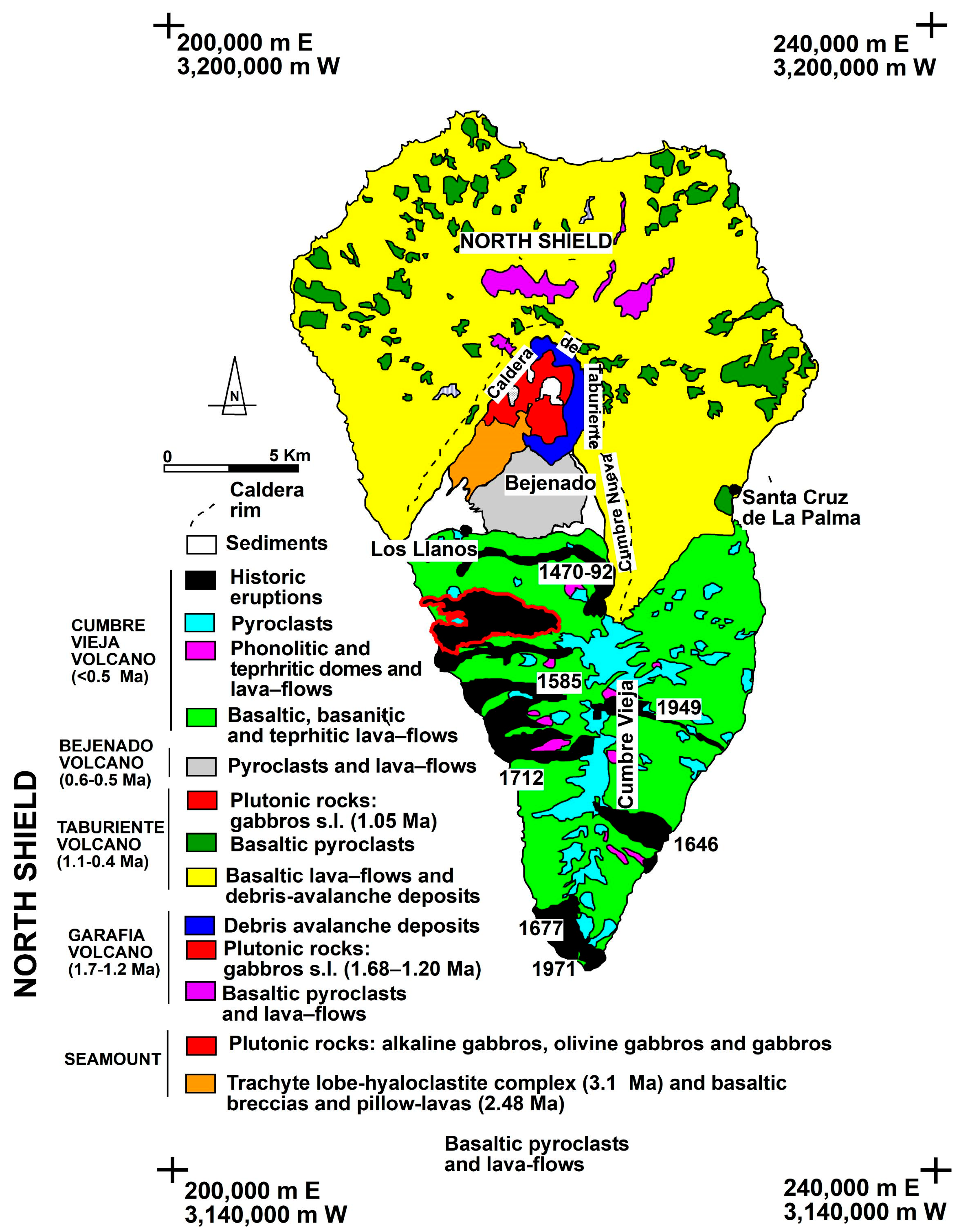
2. Materials and Methods: Spectroscopy
3. Results and Discussion
3.1. Description and Interpretation of Facies
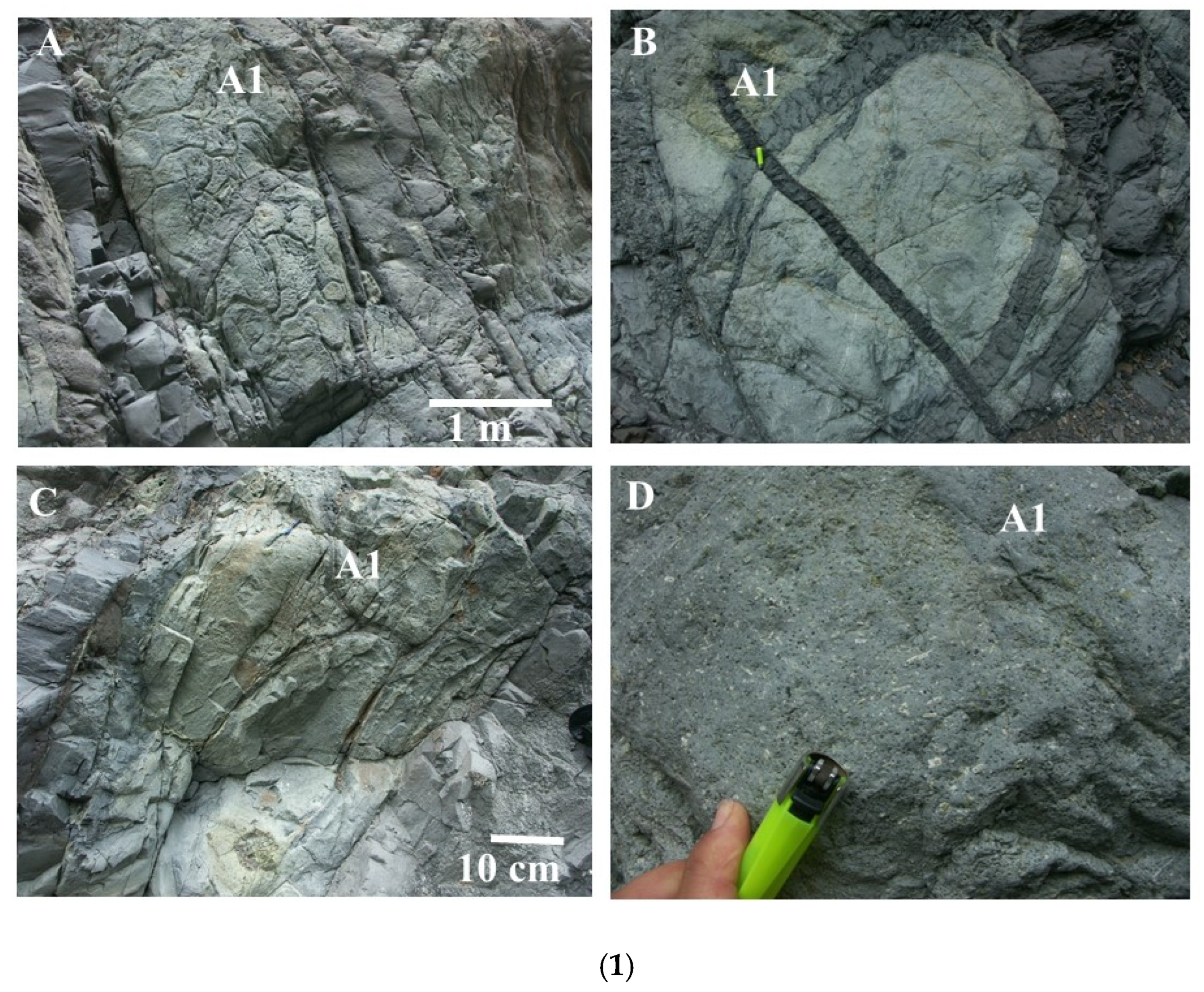
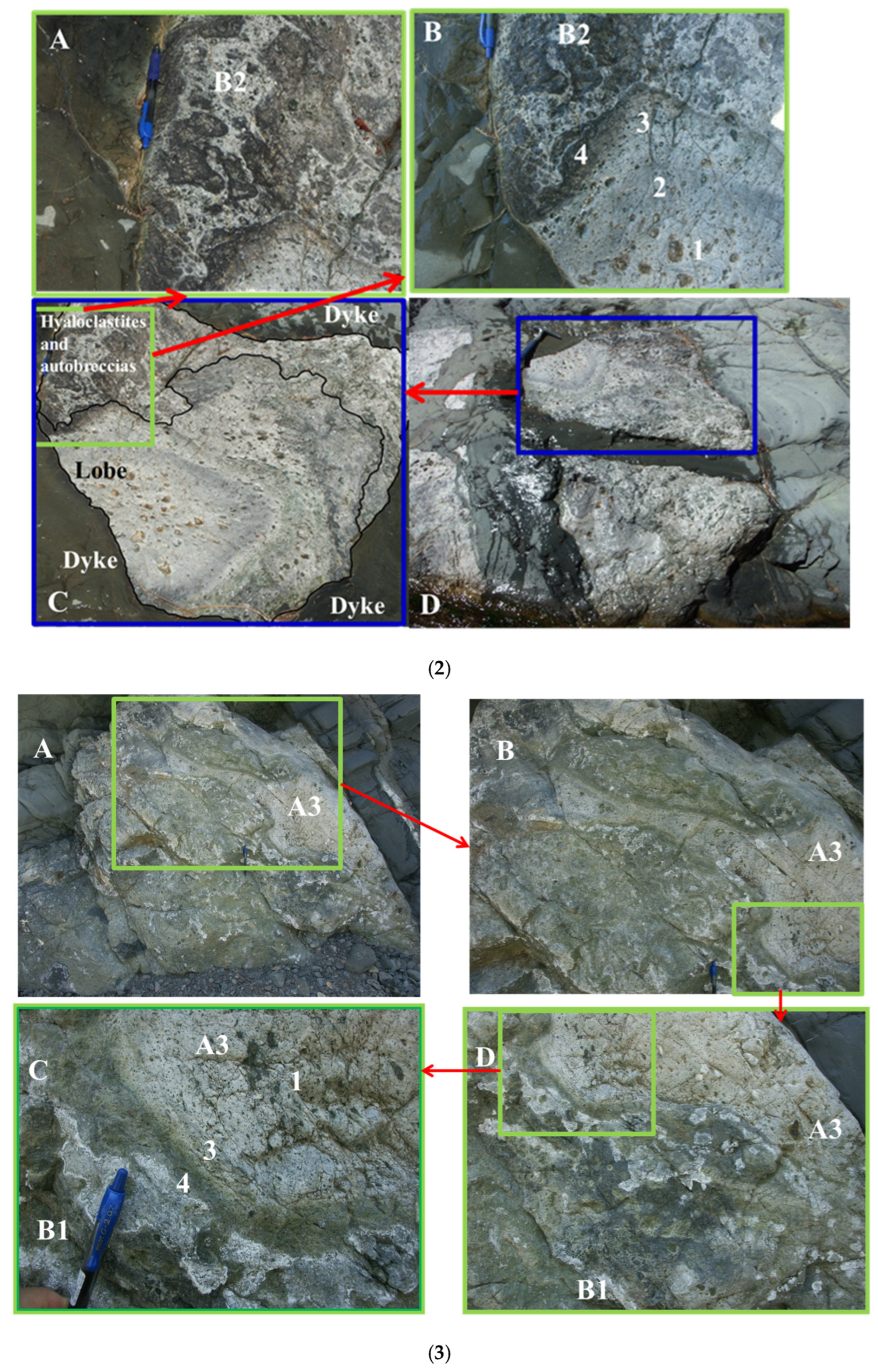
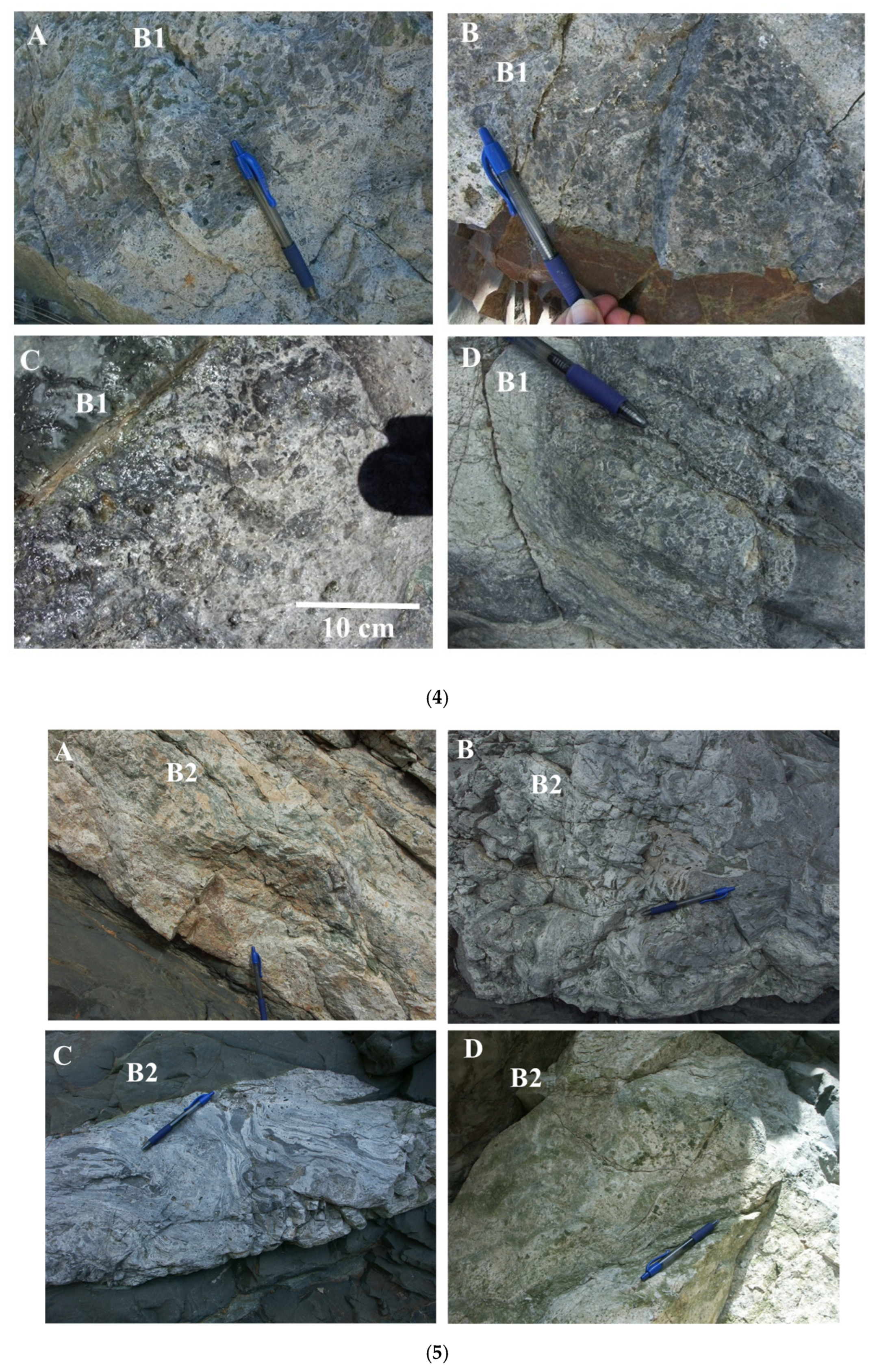
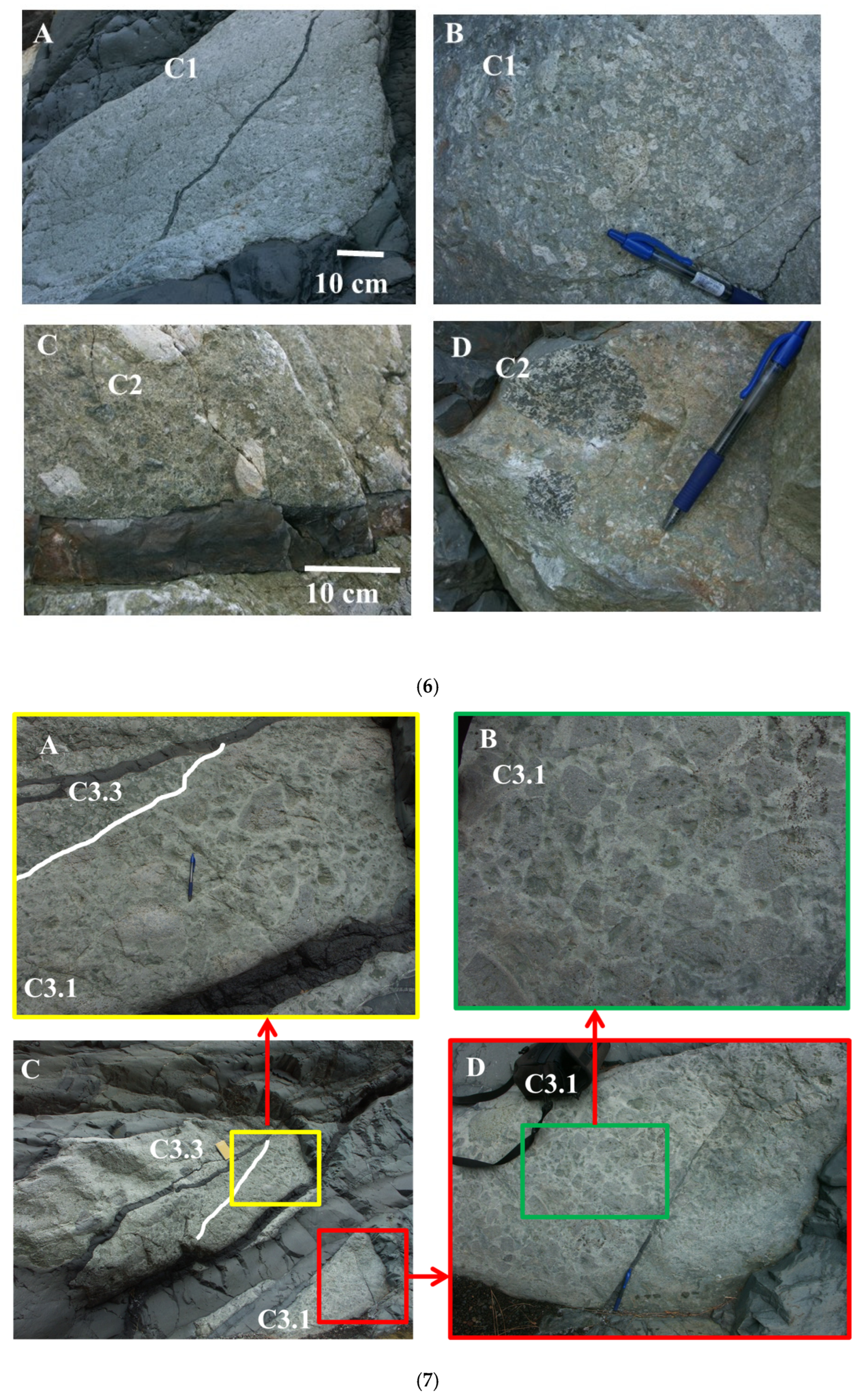
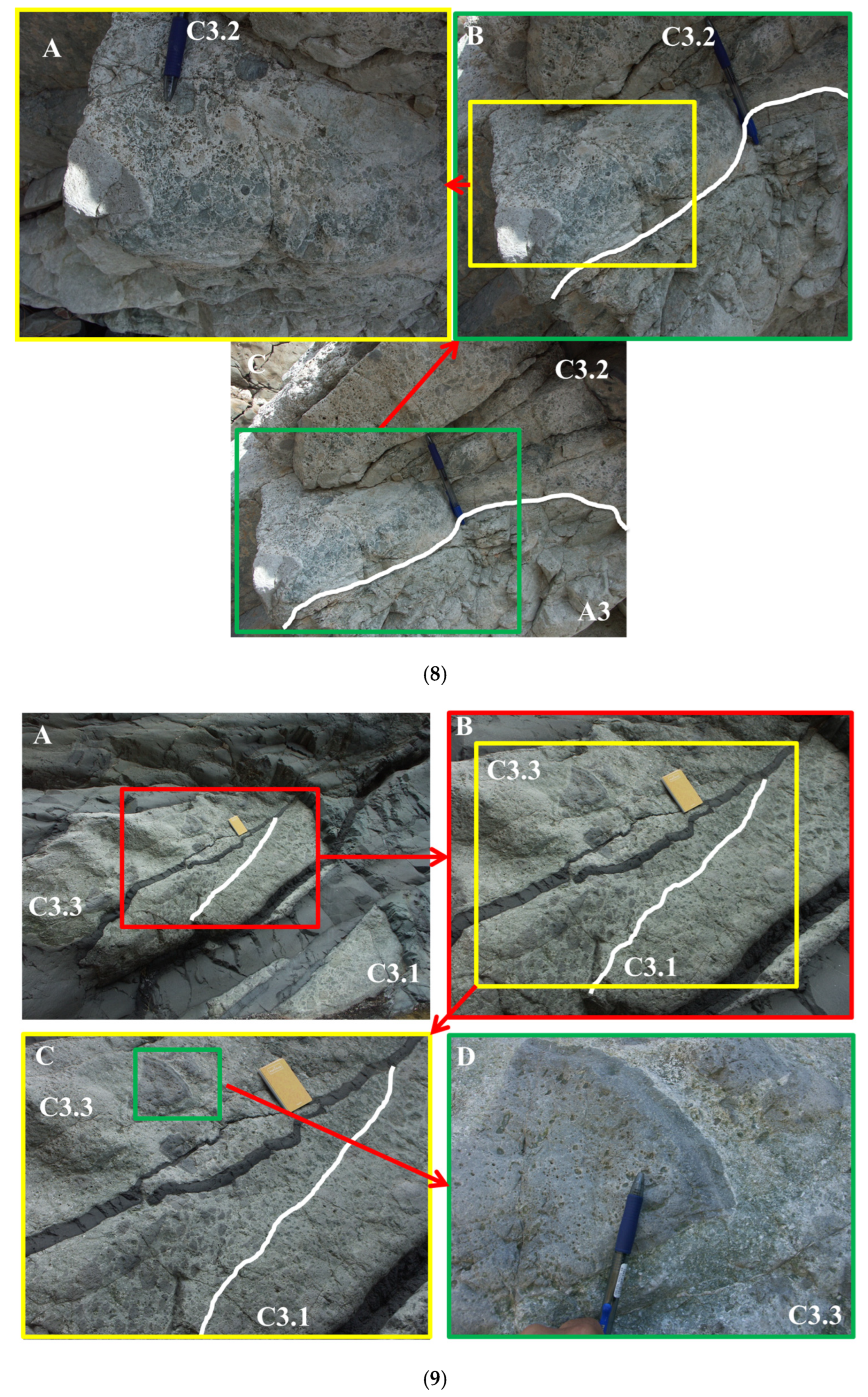
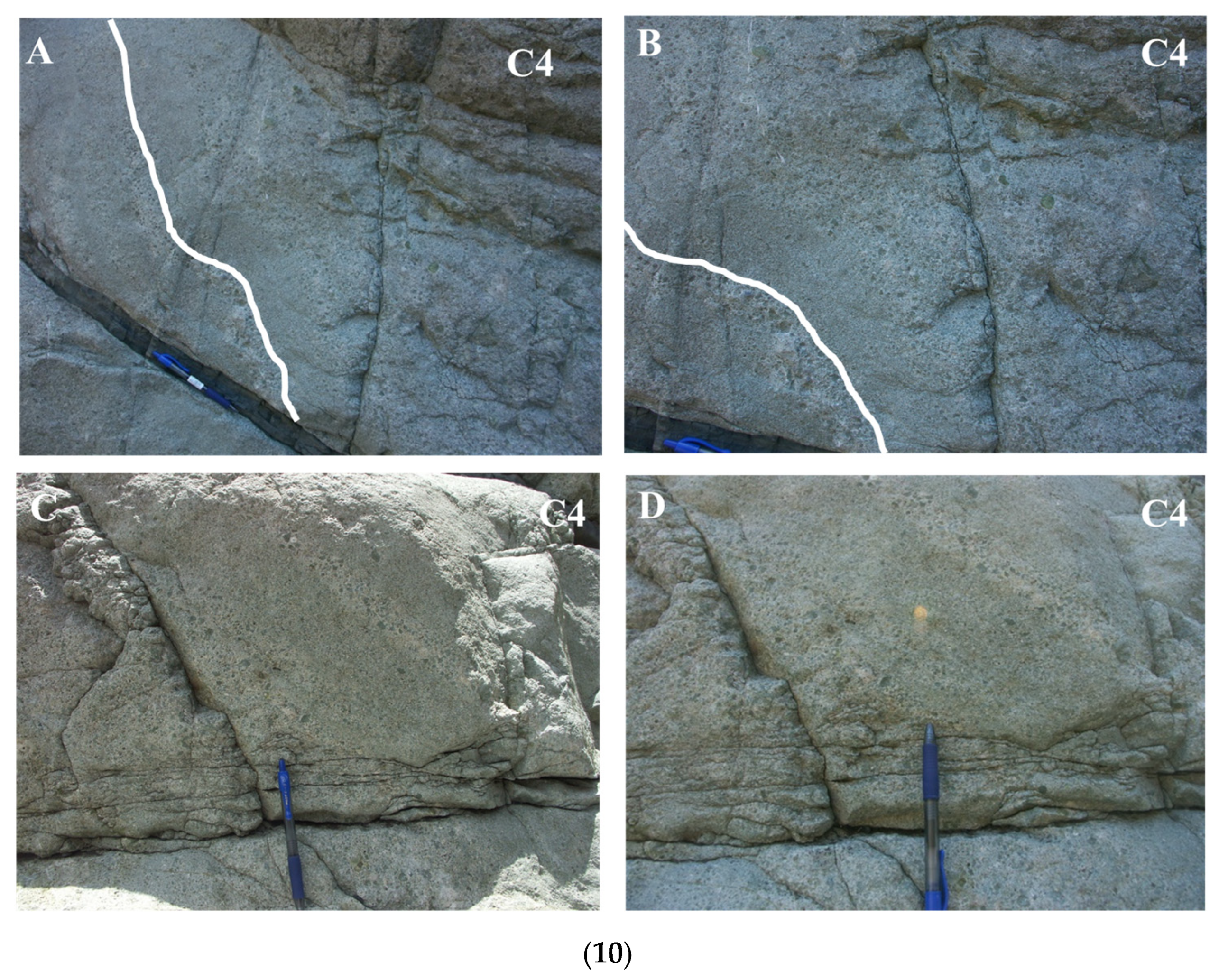
3.2. Meaning of the Submarine Felsic Episode
- (1)
- Massive proximal deposits with densely stacked lobes more than 100 m long, which start from a central feeder dam, arranged down the slope, and which, due to their higher viscosity and lower temperature, differ in shape from the lobes of basaltic and trachybasaltic flows (pillow lavas).
- (2)
- The middle zone of hyaloclastite lobes: 2–100 m long lobes surrounded by hyaloclastite and brecciated lavas with flow banding.
- (3)
- The distal breccia zone: hyaloclastitic matrix-supported breccia with lobe clasts and few brecciated lobes with “jigsaw-fit” or clast-rotated textures. Two types of breccias are distinguished: (a) autobreccias forming a shell that overlies the lobes (clasts with flow bands in a chaotic arrangement) and (b) hyaloclastitic flank breccias (clast-supported, with large fragments of lobes, interspersed with stratified hyaloclastites) that form the distal and lateral edges of the complex (flank breccias). The genesis of the latter is due to the late sliding and repositioning of autobreccias and hyaloclastites by submarine mass flows.
3.3. Geochemical Study of the Trachytic Lobe–Hyaloclastite Complex
- The trachytes do not exhibit significant enrichment in light rare earth elements compared to the basaltic–trachybasaltic rocks, supporting the interpretation that the two are not genetically related.
- The trachytes display a marked depletion in intermediate rare earth elements (MREEs), consistent with the fractional crystallization of sphene and apatite—an observation that aligns with the Ti and P depletion shown in Figure 9. The negative Eu anomaly in the trachytes suggests fractional crystallization of plagioclase during the differentiation process. In contrast, the mugearitic and benmoreitic dykes that intrude the trachytes do not show this MREE depletion. Instead, they exhibit slight MREE enrichment, further indicating that they are not cogenetic with the trachytes of the lobe–hyaloclastite complex.
3.4. Age of the Lobe–Hyaloclastite Rocks Complex
3.5. Significance of the La Palma Trachyte Submarine Lobe–Hyaloclastitic Complex in the Regional Context of the Canary Islands
4. Conclusions
Supplementary Materials
Author Contributions
Funding
Data Availability Statement
Acknowledgments
Conflicts of Interest
References
- Morgan, W.J. Convection Plumes in the Lower Mantle. Nature 1971, 230, 42–43. [Google Scholar] [CrossRef]
- Troll, V.R.; Deegan, F.M.; Burchardt, S.; Zaczek, K.; Carracedo, J.C.; Meade, F.C.; Soler, V.; Cachao, M.; Ferreira, J.; Barker, A.K. Nannofossils: The smoking gun for the Canarian hotspot. Geol. Today 2015, 31, 137–145. [Google Scholar] [CrossRef]
- Hoernle, K.; Schmincke, H.U. The role of partial melting in the 15-Ma geochemical evolution of Gran Canaria: A blobmodel for the Canary hotspot. J. Pet. 1993, 34, 599–626. [Google Scholar] [CrossRef]
- King, S.D.; Ritsema, J. African hot spot volcanism: Small-scale convection in the upper mantle beneath cratons. Nature 2000, 290, 1137–1140. [Google Scholar] [CrossRef]
- Geldmacher, J.; Hoernle, K.; Bogaard, P.V.D.; Duggen, S.; Werner, R. New 40Ar/39Ar age and geochemical data from seamounts in the Canary and Madeira volcanic provinces: A contribution to the “Great Plume Debate”. Earth Planet. Sci. Lett. 2005, 237, 85–101. [Google Scholar] [CrossRef]
- Gurenko, A.A.; Hoernle, K.A.; Sobolev, A.V.; Hauff, F.; Schmincke, H.U. Source components of the Gran Canaria (Canary Islands) shield stage magmas: Evidence from olivine composition and Sr-Nd-Pb isotopes. Contrib. Mineral. Petrol. 2010, 159, 689–702. [Google Scholar] [CrossRef]
- Anguita, F.; Hernán, F. A propagating fracture model versus a hot-spot origin for the Canary Islands. Earth Planet. Sci. Lett. 1975, 27, 11–19. [Google Scholar] [CrossRef]
- Araña, V.; Ortiz, R. The Canary Islands: Tectonics, magmatism and geodynamic framework. In Magmatism in Extensional Structural Settings: The Phanerozoic African Plate; Kampunzu, A.B., Lubala, R.T., Eds.; Springer: New York, NY, USA, 1991; pp. 209–249. [Google Scholar]
- Anguita, F.; Hernán, F. The Canary Islands origin: A unifying model. J. Volcanol. Geotherm. Res. 2000, 103, 1–26. [Google Scholar] [CrossRef]
- Anguita, F.; Fernández, C.; Márquez, Á.; Álvarez-León, R.; Casillas, R. The Canary hotspot revisited: Refutation of the Hawaii paradigm and an alternative, plate-based hypothesis. Earth-Sci. Rev. 2025, 261, 105038. [Google Scholar] [CrossRef]
- Iyer, S.D.; Mehta, C.M.; Das, P.; Kalangutkar, N.G. Seamounts—Characteristics, formation, mineral deposits and biodiversity. Geol. Acta 2012, 10, 295–308. [Google Scholar] [CrossRef]
- Conrad, C.P.; Selway, K.; Hirschmann, M.M.; Ballmer, M.D.; Wessel, P. Constraints on volumes and patterns of asthenospheric melt from the space-time distribution of seamounts. Geophys. Res. Lett. 2017, 44, 7203–7210. [Google Scholar] [CrossRef]
- Kim, S.S.; Wessel, P. New global seamount census from altimetry-derived gravity data. Geophys. J. Int. 2011, 186, 615–631. [Google Scholar] [CrossRef]
- Harris, P.T.; Macmillan-Lawler, M.; Ruppc, J.; Baker, E.K. Geomorphology of the oceans. Mar. Geol. 2014, 352, 4–24. [Google Scholar] [CrossRef]
- Wessel, P. Global distribution of seamounts inferred fromgridded Geosat/ERS-1 altimetry. J. Geophys. Res. 2001, 106, 19431–19441. [Google Scholar] [CrossRef]
- Kitchingman, A.; Lai, S. Inferences on potential seamount locations from midresolution bathymetric data. In FCRR Seamounts: Biodiversity and Fisheries; Morato, T., Pauly, D., Eds.; Fisheries Centre Research Reports; University of British Columbia: Vancouver, BC, Canada, 2004; pp. 7–12. [Google Scholar]
- Yesson, C.; Clark, M.R.; Taylor, M.L.; Rogers, A.D. The global distribution of seamounts based on 30 arc seconds bathymetry data. Deep Sea Research Part I: Oceanographic. Res. Pap. 2011, 58, 442–453. [Google Scholar]
- Lonsdale, P.; Batiza, R. Hyaloclastite and lava flows on young seamounts examined with a submersible. Geol. Soc. Am. Bull. 1980, 91, 545–554. [Google Scholar] [CrossRef]
- Batiza, R.; Fornari, D.J.; Vanko, D.A.; Lonsdale, P. Craters, calderas, and hyaloclastites on young Pacific seamounts. J. Geophys. Res. 1984, 89, 8371–8390. [Google Scholar] [CrossRef]
- Fornari, D.J.; Ryan, W.B.F.; Fox, P.J. The Evolution of Craters and Calderas on Young Seamounts–Insights from Sea Marc-I and Sea Beam Sonar Surveys of a Small Seamount Group near the Axis of the East Pacific Rise at Approximately 10-Degrees-N. J. Geophys. Res. 1984, 89, 1069–1083. [Google Scholar] [CrossRef]
- Vogt, P.R.; Smoot, N.C. The Geisha guyots—Multibeam bathymetry and morphometric interpretation. J. Geophys. Res. 1984, 89, 1085–1107. [Google Scholar] [CrossRef]
- Moore, J.G.; Clague, D.A. Volcano growth and evolution of the island of Hawaii. Geol. Soc. Am. Bull. 1992, 104, 1471–1484. [Google Scholar] [CrossRef]
- Wright, I.C.; Gamble, J.A. Southern Kermadec submarine caldera arc volcanoes (SW Pacific). Caldera formation by effusive and pyroclastic eruption. Mar. Geol. 1992, 161, 207–227. [Google Scholar] [CrossRef]
- Clague, D.A.; Moore, J.G.; Andy Reynolds, J.R. Formation of submarine flat-topped volcanic cones in Hawaii. Bull. Volcanol. 2000, 62, 214–233. [Google Scholar] [CrossRef]
- Mitchell, N.C. Transition from circular to stellate forms of submarine volcanoes. J. Geophys. Res. Solid Earth 2001, 106, 1987–2003. [Google Scholar] [CrossRef]
- Mitchell, N.C.; Masson, D.G.; Watts, A.B.; Gee, M.J.R.; Urgeles, R. The morphology of the submarine flanks of volcanic ocean islands: A comparative study of the Canary and Hawaiian hotspot islands. J. Volcanol. Geotherm. Res. 2002, 115, 83–107. [Google Scholar] [CrossRef]
- Mitchell, N.C. Susceptibility of mid-ocean ridge volcanic islands and seamounts to large-scale landsliding. J. Geophys. Res. 2003, 108, 2397. [Google Scholar] [CrossRef]
- Chadwick, W.W.; Wright, I.C.; Schwarz-Schampera, U.; Hyvernaud, O.; Reymond, D.; de Ronde, C.E.J. Cyclic eruptions and sector collapses at Monowai submarine volcano, Kermadec arc: 1998–2007. Geochem. Geophys. Geosyst. 2008, 9, Q10014. [Google Scholar] [CrossRef]
- Hoernle, K.; Hauff, F.; van den Bogaard, P.; Werner, R.; Mortimer, N.; Geldmacher, J.; Schönberg, D.G.; Davy, B. Age and geochemistry of volcanic rocks from the Hikurangi and Manihiki oceanic Plateaus. Geochim. Cosmochim. Acta 2010, 74, 7196–7219. [Google Scholar] [CrossRef]
- Skolotnev, S.G.; Peyve, A.A.; Turko, N.N. New Data on the Structure of the Vitoria–Trindade Seamount Chain (Western Brazil Basin, South Atlantic). Dokl. Earth Sci. 2010, 431, 435–440. [Google Scholar] [CrossRef]
- Skolotnev, S.G.; Peive, A.A.; Eskin, A.E. New Data on the Structure of the Bahia Seamounts (Western Portion of the Brazil Basin, South Atlantic). Dokl. Earth Sci. 2010, 435, 1581–1585. [Google Scholar] [CrossRef]
- Dadd, K.A.; Locmelis, M.; Higgins, K.; Hashimoto, T. Cenozoic Volcanism of the Capel-Faust Basins, Lord Howe Rise, SW Pacific Ocean. Deep-Sea Res. II 2011, 58, 922–932. [Google Scholar] [CrossRef]
- Zhang, T.; Lin, J.; Gao, J.Y. Interactions between hotspots and the Southwest Indian Ridge during the last 90 Ma: Implications on the formation of oceanic plateaus and intra-plate seamounts. Sci. China Earth Sci. 2011, 54, 1177–1188. [Google Scholar] [CrossRef]
- Skolotnev, S.G.; Petrova, V.V.; Peyve, A.A. Origin of Submarine Volcanism at the Eastern Margin of the Central Atlantic: Investigation of the Alkaline Volcanic Rocks of the Carter Seamount (Grimaldi Seamounts). Petrology 2012, 20, 59–85. [Google Scholar] [CrossRef]
- Milano, G.; Passaro, S.; Sprovieri, M. Present-day knowledge on the Palinuro Seamount (south-eastern Tyrrhenian Sea). Boll. Di Geofis. Teor. Ed Appl. 2012, 53, 403–416. [Google Scholar] [CrossRef]
- Pe-Piper, G.; Meredyk, S.; Zhang, Y.; Piper, D.J.W.; Edinger, E. Petrology and tectonic significance of seamounts within transitional crust east of Orphan Knoll, offshore eastern Canada. Geo-Marire Lett. 2013, 33, 433–447. [Google Scholar] [CrossRef]
- Anokhina, V.M.; Mel’nikovb, M.E. Morphostructural Features of the Butakov Guyot (Magellan Seamounts, Pacific Ocean). Russ. J. Pac. Geol. 2013, 7, 65–76. [Google Scholar] [CrossRef]
- Tempera, F.; Hipólito, A.; Madeira, J.; Vieira, S.; Campos, A.S.; Mitchell, N.C. Condor seamount (Azores, NE Atlantic): A morpho-tectonic interpretation. Deep-Sea Res. II 2013, 98, 7–23. [Google Scholar] [CrossRef]
- Leat, P.T.; Day, S.J.; Tate, A.J.; Martina, T.J.; Owene, M.J.; Tappin, D.R. Volcanic evolution of the South Sandwich volcanic arc, South Atlantic, from multibeam bathymetry. J. Volcanol. Geotherm. Res. 2013, 265, 60–77. [Google Scholar] [CrossRef]
- Clague, D.A.; Dreyer, B.M.; Paduan, J.B.; Martin, J.F.; Chadwick, W.; Caress, D.W.; Portner, R.A.; Guilderson, T.P.; McGann, M.L.; Thomas, H.; et al. Geologic history of the summit of Axial Seamount, Juan de Fuca Ridge. Geochem. Geophys. Geosyst. 2013, 14, 4403–4443. [Google Scholar] [CrossRef]
- Vanderkluysen, L.; Mahoney, J.J.; Koppers, A.A.P.; Beier, C.; Regelous, M.; Gee, J.S.; Lonsdale, P.F. Louisville Seamount Chain: Petrogenetic processes and geochemical evolution of the mantle source. Geochem. Geophys. Geosyst. 2014, 15, 2380–2400. [Google Scholar] [CrossRef]
- Rodrigo, C.; Díaz, J.; González-Fernández, A. Origin of the Easter Submarine Alignment: Morphology and structural lineaments. Lat. Am. J. Aquat. Res. 2014, 42, 857–870. [Google Scholar] [CrossRef][Green Version]
- Varghese, S.; Nagendran, G. Morphometric analysis of Barren volcanic base and associated tectonic elements in the Andaman fore-arc sub-basin. Curr. Sci. 2015, 108, 694–698. [Google Scholar][Green Version]
- Mel’nikova, M.E.; Pletnevb, S.P.; Anokhinc, V.M.; Sedyshevaa, T.E.; Ivanova, V.V. Volcanic Edifices on Guyots of the Magellan Seamounts. Russ. J. Pac. Geol. 2016, 10, 435–442. [Google Scholar] [CrossRef]
- Palomino, D.; Vázquez, J.T.; Somoza, L.; León, R.; López-González, N.; Medialdea, T.; Fernández-Salas, L.M.; González, F.J.; Rengel, J.A. Geomorphological features in the southern Canary Island Volcanic Province: The importance of volcanic processes and massive slope instabilities associated with seamounts. Geomorphology 2016, 255, 125–139. [Google Scholar] [CrossRef]
- Rivera, J.; Canals, M.; Lastras, G.; Hermida, N.; Amblas, D.; Arrese, B.; Martín-Sosa, P.; Acosta, J. Morphometry of Concepcion Bank: Evidence of Geological and Biological Processes on a Large Volcanic Seamount of the Canary Islands Seamount Province. PLoS ONE 2016, 11, e0156337. [Google Scholar] [CrossRef]
- Schnur, S.R.; Chadwick, W.; Embley, R.W.; Ferrini, V.L.; de Ronde, C.E.J.; Cashman, K.V.; Deardorff, N.D.; Merle, S.G.; Dziak, R.P.; Haxel, J.H.; et al. A decade of volcanic construction and destruction at the summit of NW Rota-1 seamount: 2004–2014. J. Geophys. Res. Solid Earth 2017, 122, 1558–1584. [Google Scholar] [CrossRef]
- Moore, J.G.; Fiske, R.S. Volcanic substructure inferred from dredge samples and ocean-bottom photographs, Hawaii. Geol. Soc. Am. Bull. 1969, 80, 1191–1201. [Google Scholar] [CrossRef]
- Fleet, A.J.; Mckelvey, B.C. Eocene explosive submarine volcanism, ninety east ridge, indian-ocean. Mar. Geol. 1978, 26, 73–97. [Google Scholar] [CrossRef]
- Bryan, W.B.; Humphris, S.E.; Thompson, G.; Casey, J.F. Comparative volcanology of small axial eruptive centers in the MARK area. J. Geophys. Res. Solid Earth 1994, 99, 2973–2984. [Google Scholar] [CrossRef]
- Walton, A.W.; Schiffman, P. Alteration of hyaloclastites in the HSDP 2 Phase 1 Drill Core—1. Description and paragénesis. Geochem. Geophys. Geosyst. 2003, 4, 8709. [Google Scholar] [CrossRef]
- Schmincke, H.U.; Sumita, M. Chapter 54. Instability of Oceanic Volcanic Edifices: Examples of Sector Collapse, Debris Avalanches, and Debris Flows from Gran Canaria (Canary Islands). In Submarine Mass Movements and Their Consequences 6th International Symposium; Krastel, S., Behrmann, J.-H., Volker, D., Stipp, M., Berndt, C., Urgeles, R., Chaytor, J., Huhn, K., Strasser, M., Harbitz, C.B., Eds.; Advances in Natural and Technological Hazards Research; Springer International Publishing: Cham, Switzerland, 2014; Volume 37, pp. 605–616. [Google Scholar]
- Tarduno, J.A.; Duncan, R.A.; Scholl, D.W.; Cottrell, R.D.; Steinberger, B.; Thordarson, T.; Kerr, B.C.; Neal, C.R.; Frey, F.A.; Torii, M.; et al. The Emperor Seamounts: Southward motion of the Hawaiian hotspot plume in earth’s mantle. Science 2003, 301, 1064–1069. [Google Scholar] [CrossRef]
- Clague, D.A.; Paduan, J.B.; Davis, A.S. Widespread strombolian eruptions of mid-ocean ridge basalt. J. Volcanol. Geotherm. Res. 2009, 180, 171–188. [Google Scholar] [CrossRef]
- Clague, D.A.; Rubin, K.H.; Keller, N.S. Products of submarine fountains and bubble-burst activity at 1200 m on West Mata Volcano, Lau Basin. EOS Trans. AGU 2009, 90, V43I-02. [Google Scholar]
- Koppers, A.A.P.; Russell, J.A.; Roberts, J.; Jackson, M.G.; Konter, J.G.; Wright, D.J.; Staudigel, H.; Hart, S.R. Age systematics of two young en echelon Samoan volcanic trails. Geochem. Geophys. Geosyst. 2011, 12, Q07025. [Google Scholar] [CrossRef]
- Peyve, A.A. Seamounts in the East of South Atlantic: Origin and Correlation with Mesozoic–Cenozoic Magmatic Structures of West Africa. Geotectonics 2011, 45, 195–209. [Google Scholar] [CrossRef]
- Shimoda, G.; Ishizuka, O.; Yamashita, K.; Yoshitake, M.; Ogasawara, M.; Yuasa, M. Tectonic influence on chemical composition of ocean island basalts in the West and South Pacific: Implication for a deep mantle origin. Geochem. Geophys. Geosyst. 2011, 12, Q07020. [Google Scholar] [CrossRef]
- Barker, A.K.; Troll, V.R.; Ellam, M.R.; Hansteen, T.H.; Harris, C.; Stillman, C.J.; Andersson, A. Magmatic evolution of the Cadamosto Seamount, Cape Verde: Beyond the spatial extent of EM1. Contrib. Mineral. Pet. 2012, 163, 949–965. [Google Scholar] [CrossRef]
- Skolotnev, S.G.; Peyvea, A.A.; Ivanovab, E.V.; Murdmaab, I.O.; Levchenkob, O.V.; Dmitrenkob, O.B. First Data about the Geochemistry and Geological Structure of Underwater Seamounts between Ascension and Bode Verde Transform Fracture Zones in the Brazilian Basin (South Atlantic). Dokl. Earth Sci. 2012, 442, 56–62. [Google Scholar] [CrossRef]
- Koppers, A.A.P.; Yamazaki, T.; Geldmacher, J.; The IODP Expedition 330 Scientific Party. IODP Expedition 330: Drilling the Louisville Seamount Trail in the SW Pacific. Science Reports. Sci. Drill. 2013, 15, 11–22. [Google Scholar] [CrossRef]
- Dreyer, B.M.; Clague, D.A.; Gill, J.B. Petrological variability of recent magmatism at the Axial Seamount Summit, Juan de Fuca Ridge. Geochem. Geophys. Geosyst. 2013, 14, 4306–4333. [Google Scholar] [CrossRef]
- Lezzi, J.L.; Caso, C.; Ventura, G.; Vallefuoco, M.; Cavallo, A.; Behrens, H.; Mollo, S.; Paltrinieri, D.; Signanini, P.; Vetere, F. First documented deep submarine explosive eruptions at the Marsili Seamount (Tyrrhenian Sea, Italy): A case of historical volcanism in the Mediterranean Sea. Gondwana Res. 2014, 25, 764–774. [Google Scholar] [CrossRef]
- Nichols, A.R.L.; Beier, C.; Brandl, P.A.; Buchs, D.M.; Krumm, S.H. Geochemistry of volcanic glasses from the Louisville Seamount Trail (IODP Expedition 330): Implications for eruption environments and mantle melting. Geochem. Geophys. Geosyst. 2014, 15, 1718–1738. [Google Scholar] [CrossRef][Green Version]
- Skolotnev, S.G.; Peyve, A.A.; Bylinskaya, M.E.; Golovina, L.A. New Data on the Composition and Age of Rocks from the Bathymetrists Seamounts (Eastern Margin of the Equatorial Atlantic). Dokl. Earth Sci. 2017, 472, 20–25. [Google Scholar] [CrossRef]
- Eisele, S.; Reißig, S.; Freundt, A.; Kutterolf, S.; Nürnberg, D.; Wang, K.; Kwasnitschka, T. Pleistocene to Holocene offshore tephrostratigraphy of highly explosive eruptions from the southwestern Cape Verde Archipelago. Mar. Geol. 2015, 369, 233–250. [Google Scholar] [CrossRef]
- Yan, Q.; Castillo, P.; Shi, X.; Wang, L.; Liao, L.; Ren, J. Geochemistry and petrogenesis of volcanic rocks from Daimao Seamount (South China Sea) and their tectonic implications. Lithos 2015, 218–219, 117–126. [Google Scholar] [CrossRef]
- Zhang, Y.; Meng, F.; Niu, Y. Hf isotope systematics of seamounts near the East Pacific Rise (EPR) and geodynamic implications. Lithos 2016, 262, 107–119. [Google Scholar] [CrossRef]
- Buchs, D.M.; Williams, R.; Sano, S.; Wright, V.P. Non-Hawaiian lithostratigraphy of Louisville seamounts and the formation of high-latitude oceanic islands and guyots. J. Volcanol. Geotherm. Res. 2018, 356, 1–23. [Google Scholar] [CrossRef]
- Hanyu, T.; Tejada, M.L.G.; Shimizub, K.; Ishizuka, O.; Fujii, T.; Kimura, J.; Changa, Q.; Senda, R.; Miyazaki, T.; Hirahara, Y.; et al. Collision-induced post-plateau volcanism: Evidence from a seamount on Ontong Java Plateau. Lithos 2017, 294–295, 87–96. [Google Scholar] [CrossRef]
- Pinto Ribeiro, L.; Martins, S.; Hildenbrand, A.; Madureira, P.; Mata, J. The genetic link between the Azores Archipelago and the Southern Azores Seamount Chain (SASC): The elemental, isotopic and chronological evidences. Lithos 2017, 294–295, 133–146. [Google Scholar] [CrossRef]
- Schiffman, P.; Watters, R.J.; Thompson, N.; Walton, W. Hyaloclastites and the slope stability of Hawaiian volcanoes: Insights from the Hawaiian Scientific Drilling Project’s 3-km drill core. J. Volcanol. Geotherm. Res. 2006, 151, 217–228. [Google Scholar]
- Quane, S.; Garcia, M.; Guillou, H.; Hulsebosch, T. Magmatic history of the East Rift Zone of Kilauea Volcano, Hawaii based on drill core from SOH 1. J. Volcanol. Geotherm. Res. 2000, 102, 319–338. [Google Scholar] [CrossRef]
- Sánchez-Guzman, J.; Abad, J. El sondeo geotérmico Lanzarote-1. Significado geólogico y geotérmico. In Anales de Física (Serie B). Número Especial; Real Sociedad Española de Física: Madrid, Spain, 1986; Volume 82, pp. 102–109. [Google Scholar]
- Fornari, D.J.; Peterson, D.W.; Lockwood, J.P.; Malahoff, A.; Heezen, B.C. Submarine extension of the southwest rift zone of Mauna Loa volcano, Hawaii: Visual observations from U.S. Navy deep submergence vehicle (DSV) Sea Cliff. Geol. Soc. Am. Bull. 1979, 90, 435–443. [Google Scholar] [CrossRef]
- Fornari, D.J.; Malahoff, A.; Heezen, B.C. Submarine slope micromorphology and volcanic substructure of the island of Hawaii inferred from visual observa-tions made from U.S. Navy deep-submergence vehicle (DSV) Sea Cliff. Mar. Geol. 1979, 32, 1–20. [Google Scholar] [CrossRef]
- Fornari, D.J.; Malahoff, A.; Heezen, B.C. Visual observations of the volcanic micromorphology of Tortuga, Lorraine and Tutu Seamounts; and petrology and chemistry of ridge and seamount features in and around the Panama Basin. Mar. Geol. 1979, 31, 1–30. [Google Scholar] [CrossRef]
- Chadwick, W.W.; Cashman, K.V.; Embley, R.W.; Matsumoto, H.; Dziak, R.P.; de Ronde, C.E.J.; Lau, T.K.; Deardorff, N.D.; Merle, S.G. Direct video and hydrophone observations of submarine explosive eruptions at NW Rota-1 volcano, Mariana arc. J. Geophys. Res. 2008, 113, B08S10. [Google Scholar] [CrossRef]
- Chadwick, W.W.; Embley, R.W.; Baker, E.T.; Resing, J.A.; Lupton, J.E.; Cashman, K.V.; Dziak, R.P.; Tunnicliffe, V.; Butterfield, D.A.; Tamura, Y. SPOTLIGHT 10 Northwest Rota-1 Seamount 14°36.048′ N, 144°46.519′ E. Oceanography 2010, 23, 182–183. [Google Scholar] [CrossRef]
- Schipper, C.I.; White, J.D.L. No depth limit to hydrovolcanic limu o Pele: Analysis of limu from Lō`ihi Seamount, Hawai`i. Bull. Volcanol. 2010, 72, 149–164. [Google Scholar] [CrossRef]
- Schipper, C.I.; White, J.D.L.; Houghton, B.F.; Shimizu, N.; Stewart, R.B. Explosive submarine eruptions driven by volatile-coupled degassing at Lō`ihi Seamount, Hawai`i. Earth Planet. Sci. Lett. 2010, 295, 497–510. [Google Scholar] [CrossRef]
- Schipper, C.I.; White, J.D.; Houghton, B.F. Syn- and post-fragmentation textures in submarine pyroclasts from Lō`ihi Seamount, Hawai`i. J. Volcanol. Geotherm. Res. 2010, 191, 93–106. [Google Scholar] [CrossRef]
- Schipper, C.I.; White, J.D.L.; Houghton, B.F. Textural, geochemical, and volatile evidence for a Strombolian-like eruption sequence at Lō`ihi Seamount, Hawai`i. J. Volcanol. Geotherm. Res. 2011, 207, 16–32. [Google Scholar] [CrossRef]
- Chadwick, W.; Merle, S.G.; Buck, N.J.; Lavelle, W.; Resing, J.A.; Ferrini, V. Imaging of CO2 bubble plumes above an erupting submarine volcano, NW Rota-1, Mariana Arc. Geochem. Geophys. Geosyst. 2014, 15, 4325–4342. [Google Scholar] [CrossRef]
- Portner, R.A.; Clague, D.A.; Paduan, J.B. Caldera formation and varied eruption styles on North Pacific seamounts: The clastic lithofacies record. Bull. Volcanol. 2014, 76, 845. [Google Scholar] [CrossRef]
- Portner, R.A.; Clague, D.A.; Heloc, C.; Dreyer, B.M.; Paduan, J.B. Contrasting styles of deep-marine pyroclastic eruptions revealed from Axial Seamount push core records. Earth Planet. Sci. Lett. 2015, 423, 219–231. [Google Scholar] [CrossRef]
- Embley, R.W.; Chadwick, W.W.; Baker, E.T.; Butterfield, D.A.; Resing, J.A.; De Ronde, C.E.J.; Tunnicliffe, V.; Lupton, J.E.; Juniper, S.K.; Rubin, K.H.; et al. Long-term eruptive activity at a submarine arc volcano. Nature 2006, 441, 494–497. [Google Scholar] [CrossRef]
- Konter, J.G.; Staudigel, H.; Blichert-Toft, J.; Hanan, B.B.; Polvé, J.R.; Davies, M.; Shimizu, N.; Schiffman, P. Geochemical stages at Jasper Seamount and the origin of intraplate volcanoes. Geochem. Geophys. Geosyst. 2009, 10, Q02001. [Google Scholar] [CrossRef]
- Davis, A.S.; Clague, D.A.; Paduan, J.B.; Cousens, B.L.; Huard, J. Origin of volcanic seamounts at the continental margin of California related to changes in plate margins. Geochem. Geophys. Geosyst. 2010, 11, Q05006. [Google Scholar] [CrossRef]
- Deardorff, N.D.; Cashman, K.V.; Chadwick, W.W. Observations of eruptive plume dynamics and pyroclastic deposits from submarineexplosive eruptions at NW Rota-1, Mariana arc. J. Volcanol. Geotherm. Res. 2011, 202, 47–59. [Google Scholar] [CrossRef]
- Coumans, J.P.; Stix, J.; Clague, D.A.; Minarik, W.G. The Magmatic Architecture of Taney Seamount-A, NE Pacific Ocean. J. Petrol. 2015, 56, 1037–1067. [Google Scholar] [CrossRef]
- Schwartz, D.M.; Wanless, V.D.; Berg, R.; Jones, M.P.; Fornari, D.J.; Soule, S.A.; Lytle, M.L.; Carey, S. Petrogenesis of alkalic seamounts on the Galápagos Platform. Deep. Sea Res. Part II Top. Stud. Oceanogr. 2018, 150, 170–180. [Google Scholar] [CrossRef]
- Kelley, D.S.; Delaney, J.R.; Juniper, S.K. Establishing a new era of submarine volcanic observatories: Cabling Axial Seamount and the Endeavour Segment of the Juan de Fuca Ridge. Mar. Geol. 2014, 352, 426–450. [Google Scholar] [CrossRef]
- Nooner, S.L.; Chadwick, W.W. Inflation-predictable behavior and co-eruption deformation at Axial Seamount. Science 2016, 354, 1399–1403. [Google Scholar] [CrossRef]
- Sigmundsson, F. New insights into magma plumbing along rift systems from detailed observations of eruptive behavior at Axial volcano. Geophys. Res. Lett. 2016, 43, 12423–12427. [Google Scholar] [CrossRef]
- Wilcock, W.S.D.; Dziak, R.P.; Tolstoy, M.; Chadwick, W.W., Jr.; Nooner, S.L.; Bohnenstiehl, D.R.; Caplan-Auerbach, J.; Waldhauser, F.; Arnulf, A.F.; Baillard, C.; et al. The recent volcanic history of Axial Seamount: Geophysical insights into past eruption dynamics with an eye toward enhanced observations of future eruptions. Oceanography 2018, 31, 114–123. [Google Scholar] [CrossRef]
- Tolstoy, M.; Wilcock, M.S.D.; Tan, Y.J.; Waldhauser, F. A tale of two eruptions: How data from Axial Seamount led to a discovery on the East Pacific Rise. Oceanography 2018, 31, 124–125. [Google Scholar] [CrossRef]
- Hildebrand, J.A.; Dorman, L.M.; Hammer, P.T.C.; Schreiner, A.E.; Cornuelle, B.D. Seismic tomography of Jasper Seamount. Geophys. Res. Lett. 1989, 16, 1355–1358. [Google Scholar] [CrossRef]
- Hildebrand, J.A.; Stevenson, J.M.; Hammer, P.T.C.; Zumberge, M.A.; Parker, R.L.; Fox, C.G.; Meis, P.J. A seafloor and sea surface gravity survey of Axial Volcano. J. Geophys. Res. Solid Earth 1990, 95, 12751–12763. [Google Scholar] [CrossRef]
- Hammer, P.T.C.; Dorman, L.M.; Hildebrand, J.A.; Cornuelle, B.D. Jasper Seamount structure: Seafloor seismic refraction tomography. J. Geophys. Res. Solid Earth 1994, 99, 6731–6752. [Google Scholar] [CrossRef]
- Gilbert, L.A.; McDuff, R.E.; Johnson, H.P. Porosity of the upper edifice of Axial Seamount. Geology 2007, 35, 49–52. [Google Scholar] [CrossRef]
- García-Abdeslem, J. Density modeling of the Escollos Alijos Seamount from inversion of its geoid undulation anomaly. Geofísica Int. 2014, 53, 333–341. [Google Scholar] [CrossRef][Green Version]
- Lomtev, V.L.; Patrikeev, V.N. New Evidence for the Structure of Conical Seamounts and Hills at the Foot of the Sea of Okhotsk Margin of the Kuril Island Arc: Continuous SeismicProfiling Data. J. Volcanol. Seismol. 2015, 9, 104–115. [Google Scholar] [CrossRef]
- Wang, J.; Zhao, M.; Qiu, X.; Sibuet, J.C.; He, E.; Zhang, J.; Tao, C. 3D seismic structure of the Zhenbei–Huangyan seamounts chain in the East Sub-basin of the South China Sea and its mechanism of formation. Geol. J. 2016, 51, 448–463. [Google Scholar] [CrossRef]
- Jokat, W.; Reents, S. Hotspot volcanism in the southern South Atlantic: Geophysical constraints on the evolution of the southernWalvis Ridge and the Discovery Seamounts. Tectonophysics 2017, 716, 77–89. [Google Scholar] [CrossRef]
- Jones, J.G. Intraglacial volcanoes of south-west iceland and their significance in interpretation of form of marine basaltic volcanoes. Nature 1966, 212, 586–588. [Google Scholar] [CrossRef]
- Macpherson, G.J. The Snow Mountain volcanic complex—An on-land seamount in the franciscan terrain, California. J. Geol. 1983, 91, 73–92. [Google Scholar] [CrossRef]
- Staudigel, H.; Schmincke, H.U. The pliocene seamount series of La Palma Canary-Islands. J. Geophys. Res. 1984, 89, 1195–1215. [Google Scholar] [CrossRef]
- Staudigel, H.; Feraud, G.; Giannerini, G. The history of intrusive activity on the Island of La Palma (Canary Islands). J. Volcanol. Geotherm. Res. 1986, 2, 299–322. [Google Scholar] [CrossRef]
- Ayres, L.D.; Van Wagoner, N.A.; Ferreira, W.S. Voluminous shallow-water to emergent phreatomagmatic basaltic volcaniclastic rocks, Proterozoic (−1886 Ma) Amisk Lake composite volcano, Fhn Flon Greenstone Belt, Canada. SEPM Spec. Publ. 1991, 45, 175–187. [Google Scholar]
- Kano, K.; Yamamoto, T.; Takeuchi, K. A miocene island-arc volcanic seamount—The Takashibiyama formation, Shimane peninsula, sw Japan. J. Volcanol. Geotherm. Res. 1993, 59, 101–119. [Google Scholar] [CrossRef]
- Mcphie, J. A pliocene shoaling basaltic seamount: Ba volcanic group at Rakiraki, Fiji. J. Volcanol. Geotherm. Res. 1995, 64, 193–210. [Google Scholar] [CrossRef]
- Meyer, J.; Mercolli, I.; Immenhauser, A. Off-ridge alkaline magmatism and seamount volcanoes in the Masirah island ophiolite, Oman. Tectonophysics 1996, 267, 187–208. [Google Scholar] [CrossRef]
- Corcoran, P.L. Recognizing distinct portions of seamounts using volcanic facies analysis: Examples from the Archean Slave Province, NWT, Canada. Precambrian Res. 2000, 101, 237–261. [Google Scholar] [CrossRef]
- Gutiérrez, M. Estudio Petrológico, Geoquímico y Estructural de la Serie Volcánica Submarina del Complejo Basal de Fuerteventura (Islas Canarias): Caracterización del Crecimiento Submarino y de la Emersión de la Isla. Ph.D. Thesis, Department of Pedology and Geology, Universidad de La Laguna, La Laguna, Spain, 2000; pp. 1–533. [Google Scholar]
- Gutiérrez, M.; Casillas, R.; Fernández, C.; Balogh, K.; Ahijado, A.; Castillo, C. La serie volcánica submarina del Complejo Basal de Fuerteventura: Crecimiento submarino y emersión de la isla. Geogaceta 2002, 32, 250–254. [Google Scholar]
- Gutiérrez, M.; Casillas, R.; Fernández, C.; Balogh, K.; Ahijado, A.; Castillo, C.; Colmenero, J.R.; García-Navarro, E. The submarine volcanic succession of the Basal Complex of Fuerteventura, Canary Islands: A model of submarine growth and emersion of some tectonic volcanic islands. Geol. Soc. Am. Bull. 2006, 118, 785–804. [Google Scholar] [CrossRef]
- Buchs, D.M.; Arculus, R.J.; Baumgartner, P.O.; Ulianov, A. Oceanic intraplate volcanoes exposed: Example from seamounts accreted in Panama. Geology 2011, 39, 335–338. [Google Scholar] [CrossRef]
- Schnur, S.R.; Gilbert, L.A. Detailed volcanostratigraphy of an accreted seamount: Implications for intraplate seamount formation. Geochem. Geophys. Geosyst. 2012, 13, Q0AM05. [Google Scholar] [CrossRef]
- Suiting, I.; Schmincke, H.U. Iblean diatremes 3: Volcanic processes on aMiocene carbonate platform (Iblean Mountains, SE-Sicily): A comparison of deep vs. shallow marine eruptive processes. Bull. Volcanol. 2012, 74, 207–230. [Google Scholar] [CrossRef]
- Safonova, I.; Maruyama, S.; Kojima, S.; Komiya, T.; Krivonogov, S.; Koshida, K. Recognizing OIB and MORB in accretionary complexes: A new approach based on ocean plate stratigraphy, petrology and geochemistry. Gondwana Res. 2016, 33, 92–114. [Google Scholar] [CrossRef]
- Staudigel, H.; Clague, D.A. The Geological History of Deep-Sea Volcanoes Biosphere, Hydrosphere, and Lithosphere Interactions. Oceanography 2010, 23, 58–71. [Google Scholar] [CrossRef]
- Fúster, J.M.; Cendrero, A.; Gastesi, P.; Ibarrola, E.; López Ruiz, J. Geología y Volcanología de las Islas Canarias—Fuerteventura; Instituto ‘Lucas Mallada’: Huesca, Spain; Consejo Superior de Investigaciones Científicas: Madrid, Spain, 1968; pp. 1–239. [Google Scholar]
- Cendrero, A. Estudio Geológico y Petrológico del complejo basal de la Isla de La Gomera (Canarias). Estud. Geológicos 1971, 27, 3–73. [Google Scholar]
- Stillman, C.J.; Fúster, J.M.; Bennell-Baker, M.J.; Muñoz, M.; Smewing, J.D.; Sagredo, J. Basal Complex of Fuerteventura (Canary Islands) is an oceanic intrusive complex with rift-system affinities. Nature 1975, 257, 469–471. [Google Scholar] [CrossRef]
- Cendrero, A. Nota previa sobre la geologia del Complejo Basal de la isla de La Gomera (Canarias). Estud. Geológicos 1967, 23, 71–79. [Google Scholar]
- Cendrero, A. The Volcano-plutonic Complex of La Gomera. Bull. Volcanol. 1970, 84, 561–587. [Google Scholar]
- Hernández-Pacheco, A. Nota previa sobre el Complejo Basal de la Isla de La Palma (Canarias). Estud. Geológicos 1971, 27, 255–265. [Google Scholar]
- Henández-Pacheco, A.; y Fernández-Santín, S. Las formaciones volcánicas submarinas de la Caldera de Taburiente en La Palma (Canarias) y sus transformaciones metasomaticas. In Proceedings of the Symposium on Andean and Antarctic Volcanology Problems; IAVCEI: Santiago, Chile, 1974; p. 14. [Google Scholar]
- Muñoz, M.; Sagredo, J. Existencia de metamorfismos superpuestos en el Complejo Basal de Fuerteventura (Canarias). In Proceedings of the I Asamblea Nacional de Geodesia y Geofísica, Madrid, Spain, 16–19 December 1974; pp. 1287–1288. [Google Scholar]
- Robertson, A.H.F.; Stillman, C.J. Late Mesozoic sedimentary rocks of Fuerteventura, Canary Islands. Implications for West Africa continental margin evolution. J. Geol. Soc. Lond. 1979, 136, 47–60. [Google Scholar]
- Robertson, A.H.F.; Stillman, C.J. Submarine volcanic and associated sedimentary rocks of the Fuerteventura Basal Complex, Canary Islands. Geol. Mag. 1979, 116, 203–214. [Google Scholar] [CrossRef]
- Fúster, J.M.; Muñoz, M.; Sagredo, J.; Yébenes, A.; Bravo, T.; Hernández-Pacheco, A. Excursión n° 121 A + c del 26° I.G.C. a las Islas Canarias. Boletín Inst. Geológico Min. España 1980, 92, 351–390. [Google Scholar]
- Robertson, A.H.F.; Bernouilli, D. Stratigraphy facies significance of Late Mesozoic Early Tertiary sedimentary rocks of Fuerteventura (Canary Islands), Maio (Cape Verde Islands). In Geology of the Northwest African Continental Margin; Von Rad, U., Hinz, K., Sarnthein, M., y Seibold, E., Eds.; Springer: Berlin/Heidelberg, Germany, 1982; pp. 498–525. [Google Scholar]
- Cantagrel, J.M.; Fúster, J.M.; Pin, C.; Renaud, U.; Ibarrola, E. Age Miocène inférieur des carbonatites de Fuerteventura. C. R. Acad. Sci. Paris 1993, 316, 1147–1153. [Google Scholar]
- De la Nuez, J. El Complejo Intrusivo Subvolcánico de la Caldera de Taburiente (La Palma, Canarias). Ph.D. Thesis, Universidad Complutense de Madrid, Madrid, Spain, 1984; p. 401. [Google Scholar]
- Le Bas, M.J.; Rex, D.C.; Stillman, C.J. The early magmatic chronology of Fuerteventura, Canary Islands. Geol. Mag. 1986, 123, 287–298. [Google Scholar] [CrossRef]
- Stillman, C.J. A Canary Islands Dyke Swarm: Implications for the formation of oceanic islands by extensional fissural volcanism. In Mafic Dyke Swarms; Special Paper 34; Halls, H.C., Fahrig, W.J., Eds.; Geological Association of Canada: Toronto, ON, Canada, 1987; pp. 243–255. [Google Scholar]
- Muñoz, M.; Sagredo, J. Características del metamorfismo térmico producido por los eventos plutónicos intrusivos más recientes del Complejo Basal de Fuerteventura. In Proceedings of the ESF Meeting on Canarian Volcanism, Lanzarote, Spain, 30 November–3 December 1989; pp. 104–108. [Google Scholar]
- Sagredo, J.; Ancochea, E.; Brändle, J.L.; Cubas, C.R.; Fúster, J.M.; Hernandez-Pacheco, A.; y Muñoz, M. Magmatismo hipoabisal-subvolcánico y vulcanismo en un ámbito geodinámico distensivo (Fuerteventura, Islas Canarias). In Proceedings of the Meeting on Canarian Volcanism, Lanzarote, Spain, 30 November–3 December 1989. [Google Scholar]
- Ahijado, A.; Hernández-Pacheco, A. Las rocas ultramáficas alcalinas del Jable de Salinas, Fuerteventura, Islas Canarias. Rev. Soc. Geológica España 1990, 3, 275–287. [Google Scholar]
- Ahijado, A.; Palacios, T. Synchysita en las carbonatitas de la Pta. del Peñón Blanco, Fuerteventura, Islas Canarias. Geogaceta 1991, 10, 83–84. [Google Scholar]
- Ahijado, A.; Hernández-Pacheco, A.; Mata, J. Características geoquímicas de las carbonatitas de la Punta del Peñon Blanco. Fuerteventura. Canarias. Geogaceta 1991, 11, 120–122. [Google Scholar]
- Ahijado, A. Características mineralógicas de una sövita pirofanítica de la Pta. del Peñón Blanco, Fuerteventura, Canarias. Geogaceta 1992, 12, 81–82. [Google Scholar]
- Ahijado, A.; y Hernández-Pacheco, A. El complejo ultramáfico-carbonatítico del Macizo de Amanay, Fuerteventura, Islas Canarias. Actas III Congr. Geológico España VIII Congr. Latinoam. Geol. 1992, 1, 315–318. [Google Scholar]
- Renz, O.; Bernoulli, D.; Hottinger, L. Cretaceous ammonites from Fuerteventura, Canary Islands. Geol. Mag. 1992, 129, 763–769. [Google Scholar] [CrossRef]
- Muñoz, M.; Sagredo, J. Reajustes mineralógicos y geoquímicos producidos durante el metamorfismo de contacto de diques basálticos (Fuerteventura, Islas Canarias). Boletín Soc. Española Mineral. 1994, 17, 86–87. [Google Scholar]
- Ancochea, E.; Brandle, J.L.; Cubas, C.R.; Hernán, F.; Huertas, M.J. Volcanic complexes in the eastern ridge of the Canary Islands: The Miocene activity of the Island of Fuerteventura. J. Volcanol. Geotherm. Res. 1996, 70, 183–204. [Google Scholar] [CrossRef]
- Hobson, A.; Bussy, F.; Hernández, J. Shallow-level migmatization of gabbros in a metamorphic contact aureole, Fuerteventura Basal Complex, Canary Islands. J. Petrol. 1998, 39, 125–137. [Google Scholar] [CrossRef]
- Steiner, C.; Hobson, A.; Favre, P.; Stampli, G.M. Early Jurassic sea-floor spreading in the central Atlantic—The Jurassic sequence of Fuerteventura (Canary Islands). Geol. Soc. Am. Bull. 1998, 110, 1304–1317. [Google Scholar] [CrossRef]
- Ahijado, A. Las Intrusiones Plutónicas e Hipoabisales del Sector Meridional del Complejo Basal de Fuerteventura. Ph.D. Thesis, Universidad Complutense de Madrid, Madrid, Spain, 1999; pp. 1–386. [Google Scholar]
- Balogh, K.; Ahijado, A.; Casillas, R.; Fernández, C. Contributions to the chronology of the Basal Complex of Fuerteventura, Canary Islands. J. Volcanol. Geotherm. Res. 1999, 90, 81–102. [Google Scholar] [CrossRef]
- Ahijado, A.; Casillas, R.; Hernandez-Pacheco, A. The dike swarms of the Amanay Massif, Fuerteventura, Canary Islands. J. Asian Earth Sci. 2001, 19, 333–345. [Google Scholar] [CrossRef]
- Carracedo, J.C.; Badiola, E.R.; Guillou, H.; De La Nuez, J.; Pérez Torrado, F.J. Geology and volcanology of La Palma and El Hierro, Western Canaries. Estud. Geol. 2001, 57, 175–273. [Google Scholar] [CrossRef]
- Demény, A.; Vennemann, T.W.; Hegner, E.; Ahijado, A.; Casillas, R.; Nagy, G.; Homonnay, Z.; Gutierrez, M.; Szabo, C. H, O, Sr, Nd, and Pb isotopic evidence for recycled oceanic crust in the Transitional Volcanic Group of Fuerteventura, Canary Islands, Spain. Chem. Geol. 2004, 205, 37–54. [Google Scholar] [CrossRef]
- Ahijado, A.; Casillas, R.; Nagy, G.; Fernández, C. Sr-rich minerals in a carbonatite skarn, Fuerteventura, Canary Islands (Spain). Mineral. Petrol. 2005, 84, 107–127. [Google Scholar] [CrossRef]
- Muñoz, M.; Sagredo, J.; De Ignacio, C.; Fernández-Santín, S.; Jeffries, T.E. New data (U-Pb, K-Ar) on the geochronology of the alkaline-carbonatitic association of Fuerteventura, Canary Islands, Spain. Lithos 2005, 85, 140–153. [Google Scholar] [CrossRef]
- Fernández, C.; Casillas, R.; García-Navarro, E.; Gutiérrez, M.; Camacho, M.; Ahijado, A. Miocene rifting of Fuerteventura (Canary Islands). Tectonics 2006, 21, 13-1–13-18. [Google Scholar] [CrossRef]
- Casillas, R.; de la Nuez, J.; Fernández, C.; García-Navarro, E.; Colmenero, J.R.; Martín, M.C. La secuencia volcánica submarina del Complejo Basal de La Gomera. Geotemas 2008, 10, 1273–1276. [Google Scholar]
- Casillas, R.; Fernández, C.; Ahijado, A.; Gutiérrez, M.; García-Navarro, E.; Camacho, M. Excursión post-congreso n° 2: Crecimiento temprano y evolución tectónica de la Isla de Fuerteventura. In Geoguía n° 6: Itinerarios Geológicos por las Islas Canarias: Fuerteventura, Lanzarote, La Gomera y El Hierro; Pérez-Torrado, F., Cabrera, M.C., Eds.; Sociedad Geológica de España: Salamanca, Spain, 2008; pp. 59–89. [Google Scholar]
- Casillas, R.C.; Fernández, C.; Colmenero, J.R. Crecimiento temprano y evolución geológica de la Isla de Fuerteventura. In Proceedings of the 8ª Reunión del Grupo Ibérico de Petrología, Geoquímica y Geocronología, Fuerteventura, Spain, 14–17 June 2023; Comisión de Petrología, Geoquímica y Geocronología de Rocas Ígneas y Metamórficas de la Sociedad Geológica de España: La Laguna, Spain, 2023; pp. 1–191. [Google Scholar]
- Demény, A.; Casillas, R.; Vennemann, T.W.; Hegner, E.; Nagy, G.; Ahijado, A.; De La Nuez, J.; Sipos, P.; Pilet, S.; Milton, J. Plume-Related Stable Isotope Compositions and Fluid–Rock Interaction Processes in the Basal Complex of La Palma, Canary Islands; Spain Geological Society: London, UK, 2008; Volume 293, pp. 155–175. [Google Scholar]
- Démeny, A.; Casillas, R.; de la Nuez, J.; Milton, J.A.; Nagy, G. Carbonate xenoliths in La Palma: Carbonatite or alteration product? Chem. Der Erde Geochem. 2008, 68, 369–381. [Google Scholar] [CrossRef]
- Herrera, R.; Huertas, M.J.; Ancochea, E. Edades 40Ar-39Ar del Complejo Basal de la isla de La Gomera. Geogaceta 2008, 44, 7–10. [Google Scholar]
- Holloway, M.; Bussy, F. Trace element distribution among rock-forming minerals from metamorphosed to partially molten basic igneous rocks in a contact aureole (Fuerteventura, Canaries). Lithos 2008, 102, 616–639. [Google Scholar] [CrossRef]
- Holloway, M.I.; Bussy, F.; Vennemann, T.W. Low-pressure, water-assisted anatexis of basic dykes in a contact metamorphic aureole, Fuerteventura (Canary Islands): Oxygen isotope evidence for a meteoric fluid origin. Contrib. Mineral. Petrol. 2007, 155, 111–121. [Google Scholar] [CrossRef]
- Casillas, R.; Fernández, C.; Colmenero, J.R.; Nuez, J.; García-Navarro, E.; Martín, C. Deformation structures associated with the Tazo landslide (La Gomera, Canary Islands). Bull. Volcanol. 2010, 72, 945–960. [Google Scholar] [CrossRef]
- Démeny, A.; Casillas, R.; Hegner, E.; Vennemann, T.W.; Nagy, G.; Sipos, P. Geochemical and H-O-Sr-Nd isotope evidence for magmatic processes and meteoric-water interactions in the Basal Complex of La Gomera, Canary Islands. Mineral. Petrol. 2010, 98, 181–195. [Google Scholar] [CrossRef]
- Allibon, J.; Bussy, F.; Lewin, E.; Darbellay, B. The tectonically controlled emplacement of a vertically sheeted gabbro–pyroxenite intrusion: Feeder-zone of an ocean-island volcano (Fuerteventura, Canary Islands). Tectonophysics 2011, 500, 78–97. [Google Scholar]
- Allibon, J.; Ovtcharova, M.; Bussy, F.; Cosca, M.; Schaltegger, U.; Bussien, D.; Lewin, E. Lifetime of an ocean island volcano feeder zone: Constraints from U–Pb dating on coexisting zircon and baddeleyite, and 40Ar/39Ar age determinations, Fuerteventura, Canary Islands. Can. J. Earth Sci. 2011, 48, 567–592. [Google Scholar] [CrossRef]
- Casillas, R.; Démeny, A.; Nagy, G.; Ahijado, A.; Fernández, C. Metacarbonatites in the Basal Complex of Fuerteventura (Canary Islands). The role of fluid/rock interactions during contact metamorphism and anatexis. Lithos 2011, 125, 503–520. [Google Scholar] [CrossRef]
- Fernández, C.; Casillas, R.; de la Nuez, J.; Garcia-Navarro, E.; Camacho, M.A. Deformation of the substratum of a large shield volcano: Triggering factor for fast flank collapses in the old volcanic edifice of La Gomera, Canary Islands. Geol. Soc. Am. Bull. 2014, 127, 443–463. [Google Scholar] [CrossRef]
- De la Nuez, J.; Casillas, R.; Quesada, M.L.; Fernández, C.; Colmenero, J.R. Caracterización geoquímica del complejo lóbulo-hialoclastítico submarino de la Caldera de Taburiente (La Palma, Islas Canarias). Geotemas 2016, 16, 407–411. [Google Scholar]
- Casillas, R.; de la Nuez, J.; Colmenero, J.R.; Fernández, C. El Complejo Lóbulo-Hialoclastítico Traquítico de la Caldera de Taburiente (La Palma, Islas Canarias). Geotemas 2016, 16, 399–403. [Google Scholar]
- Tornare, E.; Pilet, S.; Bussy, F. Magma Differentiation in Vertical conduits Revealed by the Complementary Study of Plutonic and Volcanic Rocks from Fuerteventura (Canary Islands). J. Petrol. 2016, 57, 2221–2250. [Google Scholar] [CrossRef]
- Dahobeitia, J.J.; Banda, E. Geophysical setting of the Canary Archipielago. In Proceedings of the ESF Meeting on Canarian Volcanism, Lanzarote, Canary Islands, Spain, 30 November–3 December 1989; pp. 72–76. [Google Scholar]
- Klitgord, K.; Schouten, H. Plate kinematics of the Central Atlantic. In The Western North Atlantic Region; Geological Society of America: Boulder, CO, USA, 1986. [Google Scholar] [CrossRef]
- Prieto, G.A.; Parker, R.L.; Vernon, F.L. A Fortran 90 library for multitaper spectrum analysis. Comput. Geosci. 2009, 35, 1701–1710. [Google Scholar] [CrossRef]
- Di Paolo, F.; Ledo, J.; Ślęzak, K.; van Dorth, D.M.; Cabrera-Pérez, I.; Pérez, N.M. La Palma island (Spain) geothermal system revealed by 3D magnetotelluric data inversion. Sci. Rep. 2020, 10, 18181. [Google Scholar] [CrossRef]
- D’aUria, L.; Koulakov, I.; Prudencio, J.; Cabrera-Pérez, I.; Ibáñez, J.M.; Barrancos, J.; García-Hernández, R.; van Dorth, D.M.; Padilla, G.D.; Przeor, M.; et al. Rapid magma ascent beneath La Palma revealed by seismic tomography. Sci. Rep. 2022, 12, 17654. [Google Scholar] [CrossRef]
- Casillas, R.; De la Nuez, J.; Fernández, C.; Colmenero, J.R.; Harangi, S.; Lukács, R.; Jourdan, F. Edad de las rocas volcánicas submarinas y plutónicas del Complejo Basal de La Palma: Implicaciones en la evolución geológica temprana de la Isla. Geogaceta 2020, 67, 47–50. [Google Scholar]
- Arenas Martín, R.; Nuez Pestana, J.D.L. Características del metamorfismo hidrotermal del Complejo ·Plutónico de la Caldera de Taburiente (La Palma, Canarias). Geogaceta 1987, 3, 13–15. [Google Scholar]
- Schiffman, P.; Staudigel, H. The smectite to chlorite transition in a fossil seamount hydrothermal system: The Basement Complex of La Palma, Canary Islands. J. Metamorph. Geol. 1995, 13, 487–498. [Google Scholar] [CrossRef]
- Castillo, C.; Usera, J.; Liché, D.; De la Nuez, J.; Casillas, R. Estudio preliminar de los foraminíferos de la formación volcánica submarina de La Palma (Islas Canarias). In Proceedings of the XVIII Jornadas de la Sociedad Española de Paleontología-II Congreso Ibérico de Paleontología, Salamanca, Spain, 24 September–29 September 2002; pp. 29–30. [Google Scholar]
- Coello, J. Las aguas subterráneas en las formaciones volcánicas del Norte de La Palma (Islas Canarias). In Proceedings of the Simposio Internacional de Recursos Hidráulicos: Canarias Agua 2000, Canarias, Spain, April 1987; pp. 1–19. [Google Scholar]
- Ancochea, E.; Hernán, F.; Cendrero, A.; Cantagrel, J.M.; Fúster, J.M.; Ibarrola, E.; Coello, J. Constructive and destructive episodes in the building of a young oceanic island, La Palma, Canary Islands, an the genesis of the Caldera de Taburiente. J. Volcanol. Geotherm. Res. 1994, 60, 243–262. [Google Scholar] [CrossRef]
- Guillou, H.; Carracedo, J.C.; y Day, S.J. Dating of the Upper Pleistocene-Holocene volcanic activity of La Palma using the unspiked K—Ar technique. J. Volcanol. Geotherm. Res. 1998, 86, 137–149. [Google Scholar] [CrossRef]
- Carracedo, J.C.; Day, S.J.; Guillou, H.; Gravestock, P. Later stages of volcanic evolution of La Palma, Canary islands: Rift evolution, giant landslides, and the genesis of the Caldera de Taburiente. Geol. Soc. Am. Bull. 1999, 111, 755–768. [Google Scholar] [CrossRef]
- Carracedo, J.C.; Day, S.S.; Guillou, H.; Pérez Torrado, F.J. Giant quaternary landslides in the evolutjon of La Palma and El Hierro, Canary Islands. J. Volcanol. Geotherm. Res. 1999, 94, 165–190. [Google Scholar]
- Guillou, H.; Carracedo, J.C.; Duncan, R.A. K-Ar, 40Ar-39Ar ages and magnetostratigraphy of Brunhes and Matuyama lava sequences from La Palma Island. J. Volcanol. Geotherm. Res. 2001, 106, 175–194. [Google Scholar] [CrossRef]
- Singer, B.S.; Relle, M.K.; Hoffman, K.A.; Battle, A.; Laj, C.; Guillou, H.; Carracedo, J.C. Ar/Ar ages from transitionally magnetized lavas on La Palma, Canary Islands, and the geomagnetic instability timescale. J. Gephysical Res. 2002, 107, 2307. [Google Scholar] [CrossRef]
- Hildenbrand, A.; Gillot, P.-Y.; Soler, V.; Lahitte, P. Evidence for a persistent uplifting of La Palma (Canary Islands), inferred from morphological and radiometric data. Earth Planet. Sci. Lett. 2003, 210, 277–289. [Google Scholar] [CrossRef]
- Quidelleur, X.; Carlut, J.; Soler, V.; Valet, J.P.; Gillot, P.Y. The age and duration of the Matuyama–Brunhes transition from new K–Ar data from La Palma (Canary Islands) and revisited 40Ar/39Ar ages. Earth Planet. Sci. Lett. 2003, 208, 149–163. [Google Scholar] [CrossRef]
- Navarro, J.M.; Coello, J.J. Mapa Geológico del Parque Nacional de la Caldera de Taburiente; Ministerio de Agricultura, Pesca y Alimentación: Madrid, Spain, 1993. [Google Scholar]
- Fernández, C.; De la Nuez, J.; Casillas, R.; García Navarro, E. Stress fields associated with the growth of a large shield volcano (La Palma, Canary Islands). Tectonics 2002, 21, 367–384. [Google Scholar] [CrossRef]
- Urgeles, R.; Canals, M.; Baraza, J.; Alonso, B. Seismostratigraphy of the western flanks of El Hierro and La Palma (Canary Islands): A record of Canary Islands volcanism. Mar. Geol. 1998, 146, 225–241. [Google Scholar] [CrossRef]
- Krastel, S.; Schmincke, H.; Jacobs, C.L. Formation of submarine canyons on the flanks of the Canary Islands. Geo-Mar. Lett. 2001, 20, 160–167. [Google Scholar] [CrossRef]
- Masson, D.G.; Watts, A.B.; Gee, M.J.R.; Urgeles, R.; Mitchell, N.C.; Le Bas, T.P.; Canals, M. Slope failures on the flanks of the Canary Islands. Earth-Sci. Rev. 2002, 57, 1–35. [Google Scholar] [CrossRef]
- Acosta, J.; Uchupi, E.; Muñoz, A.; Herranz, P.; Palomo, C.; Ballesteros, M.; ZEE Working Group. Geologic evolution of the Canarian Islands of Lanzarote, Fuerteventura, Gran Canaria and La Gomera and comparison of landslides at these island with those at Tenerife, La Palma and El Hierro. Mar. Geophys. Res. 2003, 24, 1–40. [Google Scholar] [CrossRef]
- Colmenero, J.R.; de la Nuez, J.; Casillas, R.; Castillo, C. Caracteres de los conglomerados y brechas epiclásticos de La Palma (Islas Canarias) y su relación con grandes deslizamientos y génesis de la Caldera de Taburiente. Geotemas 2008, 10, 123–126. [Google Scholar]
- Colmenero, J.R.; de la Nuez, J.; Casillas, R.; Castillo, C. Epiclastic deposits associated with large-scale landslides and the formation of erosive calderas in oceanic islands: The example of the La Palma Island (Canary Archipelago). Geomorphology 2012, 177–178, 108–127. [Google Scholar] [CrossRef]
- Hernández-Pacheco, A.; De la Nuez, J. Las extrusiones sálicas del sur de la isla de La Palma. Estud. Geológicos 1983, 39, 3–30. [Google Scholar]
- Day, S.; Carracedo, J.C.; Guillou, H.; Gravestock, P. Recent structural evolution of the Cumbre Vieja Volcano, La Palma, Canary Islands: Volcanic rift zone reconfiguration as a precursor to volcanic flank instability? J. Volcanol. Geothernal Res. 1999, 94, 135–167. [Google Scholar] [CrossRef]
- Hernández-Pacheco, A. La erupción del Tahuya en 1585 y el origen de los Roques de Jedey, La Palma, Canarias. Secretariado de Publicaciones de la Universidad de La Laguna, Tomo Homenaje al prof. Telesforo Bravo 1990, 94, 425–446. [Google Scholar]
- Hernández-Pacheco, A.; Valls, C. The historic eruptions of La Palma Island (Canaries). Arquipelago, Universidade dos Açores. Série Ciências Da Nat. 1982, 3, 83–94. [Google Scholar]
- Carracedo, J.C.; Day, S.; Guillou, H.; Rodríguez Badiola, E. The 1677 eruption of La Palma, Canary Islands. Estud. Geológicos 1996, 52, 103–114. [Google Scholar] [CrossRef]
- Carracedo, J.C.; Troll, R. The Geology of the Canary Islands; Elsevier: Amsterdam, The Netherlands, 2016. [Google Scholar]
- Black, L.P.; Kamo, S.L.; Allen, C.M.; Aleinikoff, J.A.; Davis, D.W.; Korsch, J.R.; Foudolis, C. TEMORA 1: A new zircon standard for Phanerozoic U–Pb geochronology. Chem. Geol. 2003, 200, 155–170. [Google Scholar] [CrossRef]
- Claoue-Long, J.C.; Compston, W.; Roberts, J.; Fanning, C.M. Two Carboniferous ages: A comparison of SHRIMP zircon dating with conventional zircon ages and 40Ar/39Ar analysis. In Geochronology Time Scales and Global Stratigraphic Correlation; Berggren, W.A., Kent, D.V., Aubry, M.P., Hardenbol, J., Eds.; Special Publication No. 4; Society for Sedimentary Geology: Broken Arrow, OK, USA, 1995; Volume 4, pp. 3–21. [Google Scholar]
- Williams, I.S.; Claesson, S. Isotopic evidence for the Precambrian provenance and Caledonian metamorphism of high grade paragneisses from the Seve Nappes, Scandinavian Caledonides. II: Ion microprobe zircon U–Th–Pb. Contrib. Mineral. Petrol. 1987, 97, 205–217. [Google Scholar] [CrossRef]
- Dodson, M.H. A linear method for second-degree interpolation in cyclical data collection. J. Phys. E Sci. Instrum. 1978, 11, 296. [Google Scholar] [CrossRef]
- Williams, I.S. U-Th-Pb Geochronology by Ion Microprobe. In Applications of Microanalytical Techniques to Understanding Mineralizing Processes; McKibben, M.A., Shanks, W.C., III, Ridley, W.I., Eds.; Reviews in Economic Geology; Mineralogical Society of America: Washington, DC, USA, 1998; Volume 7, pp. 1–35. [Google Scholar]
- Williams, I.S.; Hergt, J.M. U-Pb dating of Tasmanian dolerites: A cautionary tale of SHRIMP analysis of high-U zircon. In Beyond 2000: New Frontiers in Isotope Geoscience; Woodhead, J.D., Hergt, J.M., Noble, W.P., Eds.; Abstracts and Proceedings; Lorne: New York, NY, USA, 2000; pp. 185–188. [Google Scholar]
- Koppers, A.A.P. ArArCALC—Software for Ar-40/Ar-39 age calculations. Comput. Geosci. 2002, 28, 605–619. [Google Scholar] [CrossRef]
- Renne, P.R.; Balco, G.; Ludwig, K.R.; Mundil, R.; Min, K. Response to the comment by W.H. Schwarz et al. on “Joint determination of 40K decay constants and 40Ar*/40K for the Fish Canyon sanidine standard and improved accuracy for 40Ar/39Ar geochronology” by P.R.Renne et al. (2010). Geochim. Cosmochim. Acta 2011, 75, 5097–5100. [Google Scholar] [CrossRef]
- Renne, P.R.; Mundil, R.; Balco, G.; Min, K.W.; Ludwig, K.R. Joint determination of 40K decay constants and 40Ar*/40K for the Fish Canyon sanidine standard and improved accuracy for 40Ar/39Ar geochronology. Geochim. Cosmochim. Acta 2010, 74, 5349–5367. [Google Scholar] [CrossRef]
- De Rosen-Spence, A.F.; Provost, G.; Dimroth, E.; Gochnauer, K.; Owen, V. Archean subaqueous felsic flows, Rouyn-Noranda, Quebec, Canada, and their Quaternary equivalents. Precamb. Res. 1980, 12, 43–77. [Google Scholar] [CrossRef]
- Cas, R.A.F. Submarine volcanism: Eruption styles, products, and relevance to understanding the host-rock succesions to volcanic-hosted massive sulphidedeposits. Econ. Geol. 1990, 87, 511–541. [Google Scholar] [CrossRef]
- Morgan, L.A.; Schultz, K.J. 5. Physical Volcanology of Volcanogenic Massive Sulfide Deposits 2012. In Scientific Investigations Report 2010–5070–C; U.S. Department of the Interior and U.S. Geological Survey: Washington, DC, USA, 2012; pp. 63–100. [Google Scholar]
- Scutter, C.; Moore, C.L.; Cas, R.A.F. Facies architecture and origin of a submarine rhyolitic lava flow–dome complex, Ponza, Italy. J. Geophys. Res. 1998, 103, 27551–27566. [Google Scholar] [CrossRef]
- Gifkins, C. Textural and Chemical Characteristics of Diagenetic and Hydrothermal Alteration in Glassy Volcanic Rocks: Examples from the Mount Read Volcanics, Tasmania. Econ. Geol. 2000, 96, 973–1002. [Google Scholar] [CrossRef]
- Stewart, A.L.; McPhie, J. Facies architecture and Late Pliocene—Pleistocene evolution of a felsic volcanic island, Milos, Greece. Bull. Volcanol. 2006, 68, 703–726. [Google Scholar] [CrossRef]
- Mulder, T.; Alexander, J. The physical character of subaqueous sedimentary density flow and their deposits. Sedimentology 2001, 48, 269–299. [Google Scholar] [CrossRef]
- Lowe, D.R. Sediment-gravity flows, II: Depositional models with special reference to the deposits of high-density turbidity currents. J. Sediment. Petrol. 1982, 52, 279–297. [Google Scholar]
- Mutti, E.; Tinterri, R.; Remacha, E.; Mavilla, N.; Angella, S.; Fava, L. An Introduction to the Analysis of Ancient Turbidite Basins from an Outcrop Perspective; Continuing Education Course Note; American Association of Petroleum Geologists: Tulsa, OK, USA, 1999; Volume 39, pp. 1–96. [Google Scholar]
- Le Maitre, R.W. Igneous Rocks a Classification and Glossary of Terms Recommendations of the International Union of Geological Sciences, Sub-Commission on the Systematics of Igneous Rocks; Cambridge University Press: Cambridge, UK, 2002; p. 236. [Google Scholar] [CrossRef]
- Klügel, A.; Hansteen, T.H.; van den Bogaard, P.; Strauss, H.; Hauff, F. Holocene fluid venting at an extinct Cretaceous seamount, Canary archipelago. Geology 2011, 39, 855–858. [Google Scholar] [CrossRef]
- Metletidis, S.; Di Roberto, A.; Pompilio, M.; Bertagnini, A.; Iribarren, I.; Felpeto, A.; Torres, P.A.; D’Oriano, C. Xenopumices from the 2011– 2012 submarine eruption of El Hierro (Canary Islands, Spain): Constraints on the plumbing system and magma ascent. Geophys. Res. Lett. 2012, 39, L17302. [Google Scholar] [CrossRef]
- Winchester, J.A.; Floyd, P.A. Geochemical discrimination of different magma series and their differentiation products using immobile elements. Chem. Geol. 1976, 20, 325–343. [Google Scholar] [CrossRef]
- López Ruiz, J.; Cebriá, J.M. Ceoquímica de Los Procesos Magmáticos; Editorial Rueda: Madrid, Spain, 1990; p. 168. [Google Scholar]
- Sun, S.; McDonough, W.F. Implications for Mantle Composition and Processes Chemical and Isotopic Systematics of Oceanic Basalts: Geological Society; Special Publications; Geological Society: London, UK, 1989; Volume 42, pp. 313–345. [Google Scholar]
- Thompson, G.; Bryan, W.B.; Frey, F.A.; Dickey, J.S.; Davies, H.L. Petrology, geochemistry and original tectonic setting of basalts from the Mozambique Basin and Ridge (DSDP Sites 248, 249 and 250), and from the Southwest Indian Ridge (DSDP Site 251). Mar. Geol. 1982, 48, 175–195. [Google Scholar] [CrossRef]
- Van den Bogaard, P. The origin of the Canary Island Seamount Province—New ages of old seamounts. Sci. Rep. 2013, 3, 2107. [Google Scholar] [CrossRef] [PubMed]
- Fernández-Santín, S. Procesos de propilitización en rocas sálicas del Complejo Basal de la isla de La Gomera. Com. III Asamb. Nac. Geod. Geof. 1979, 3, 1633–1654. [Google Scholar]
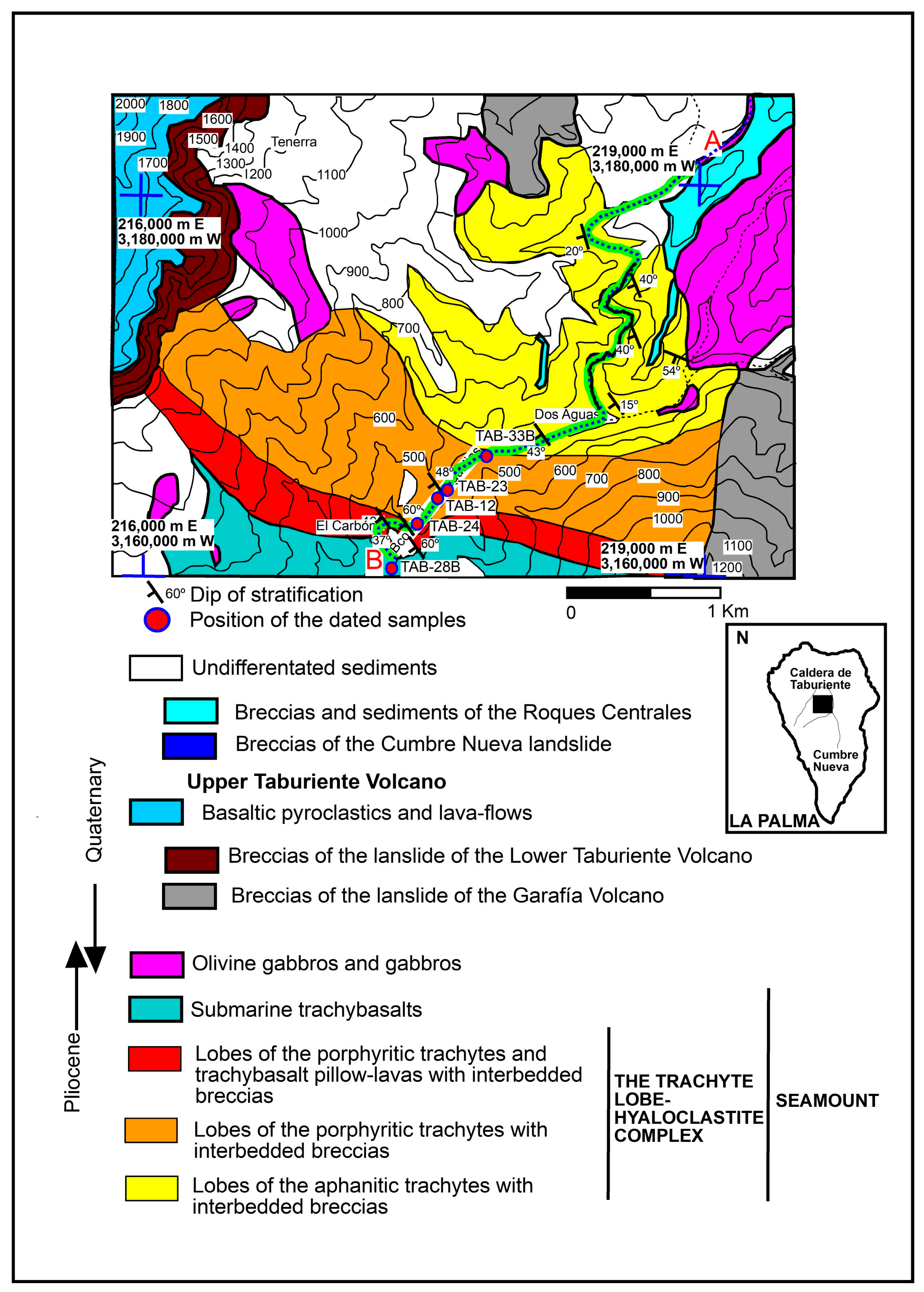

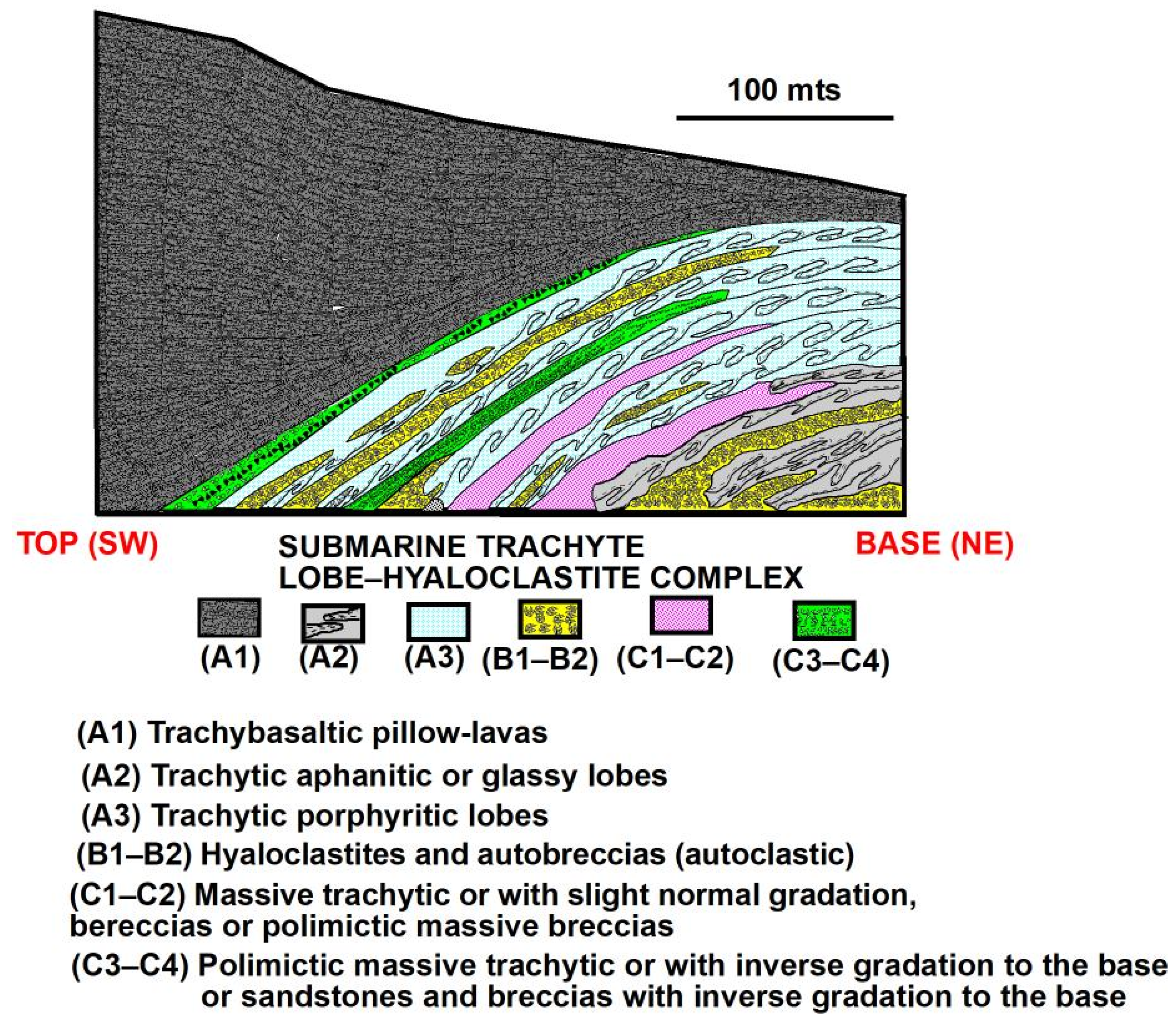
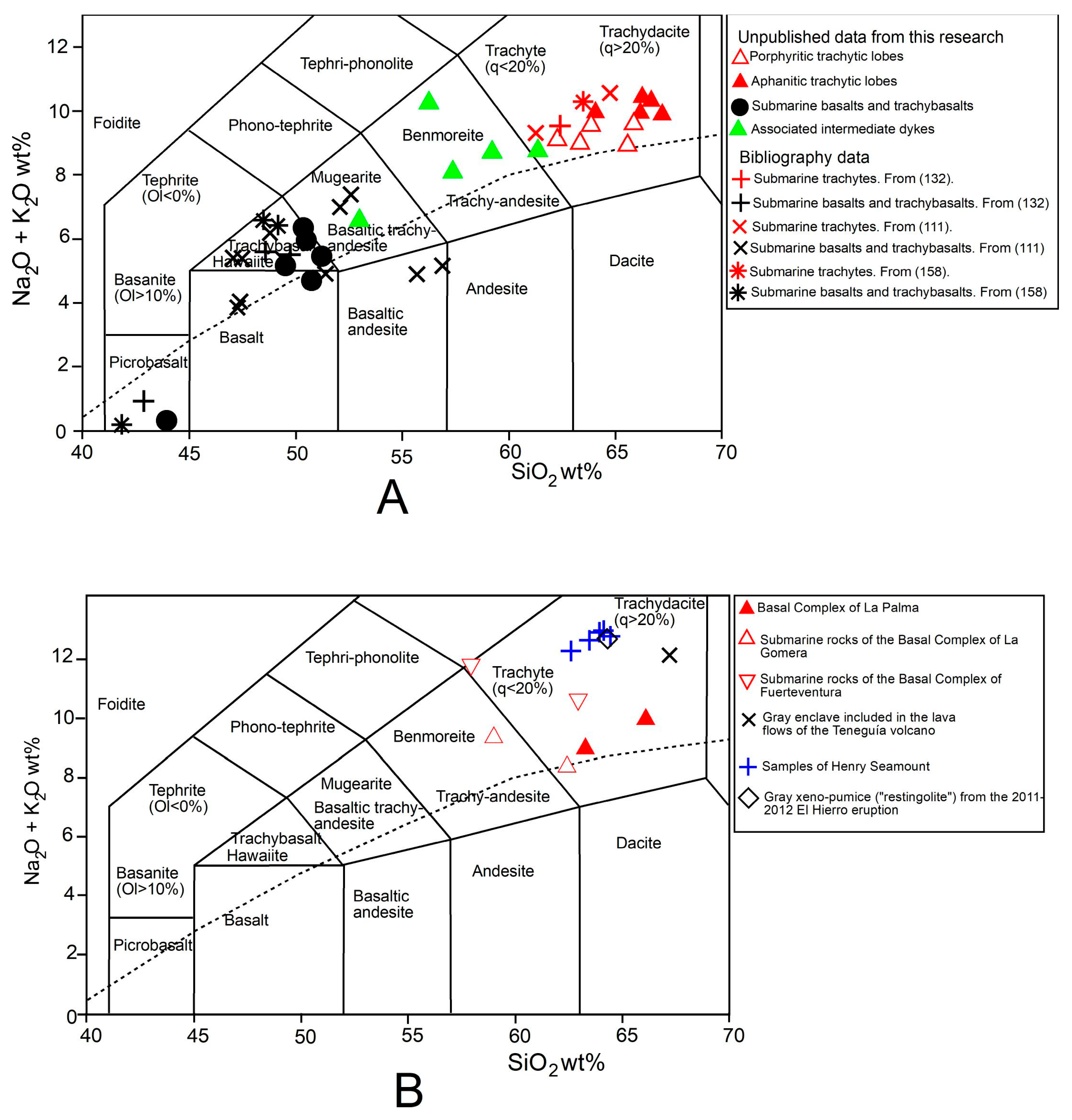
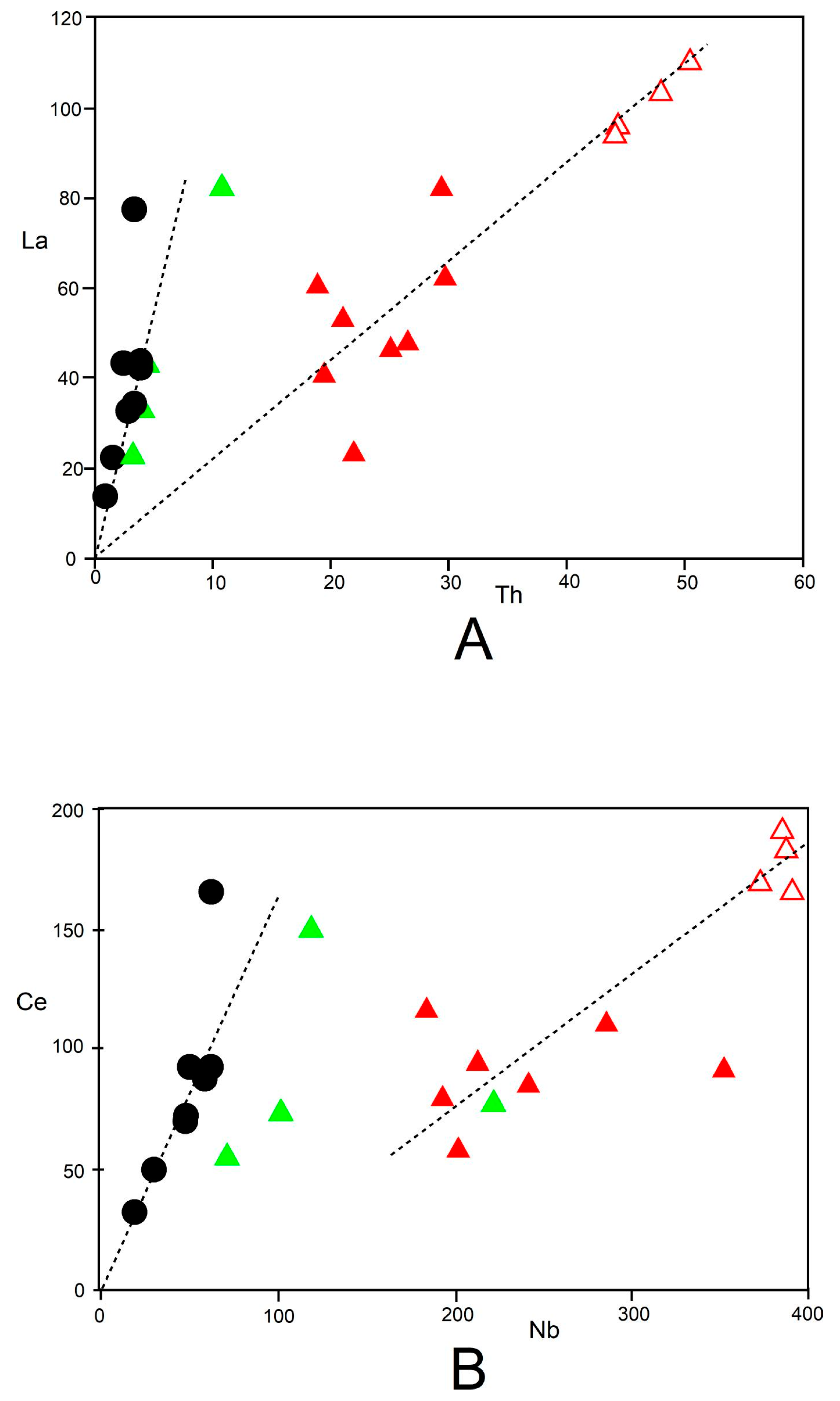
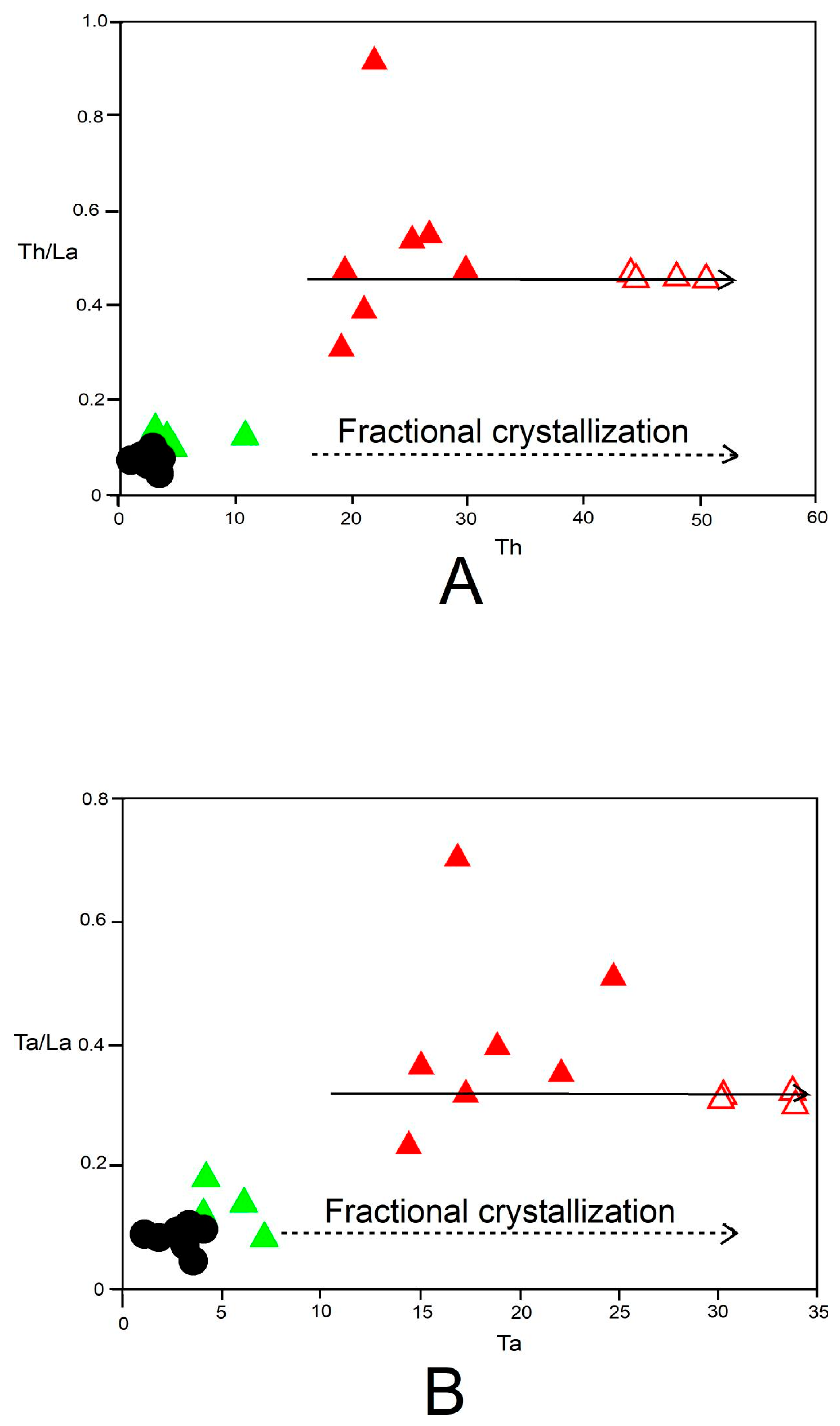
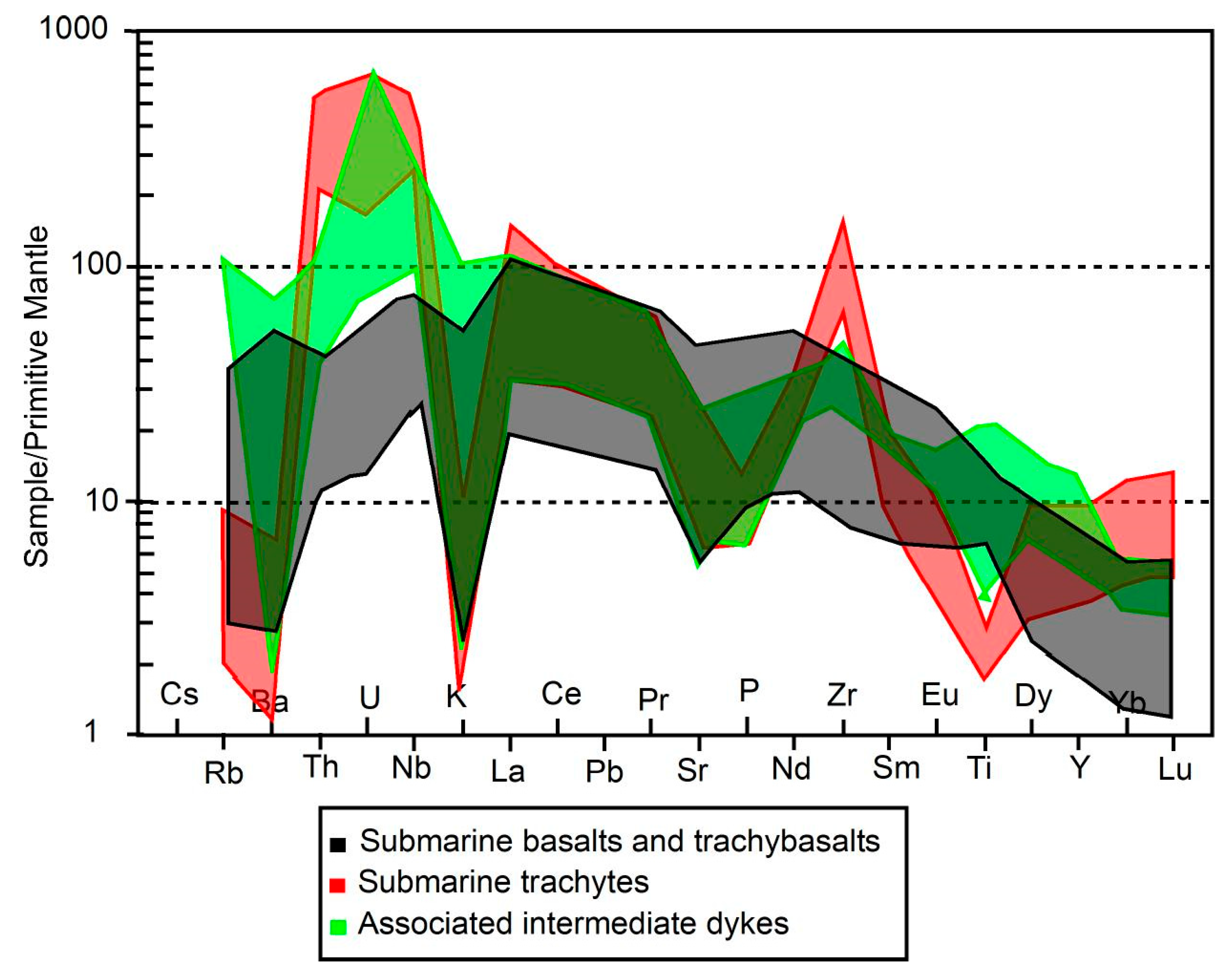
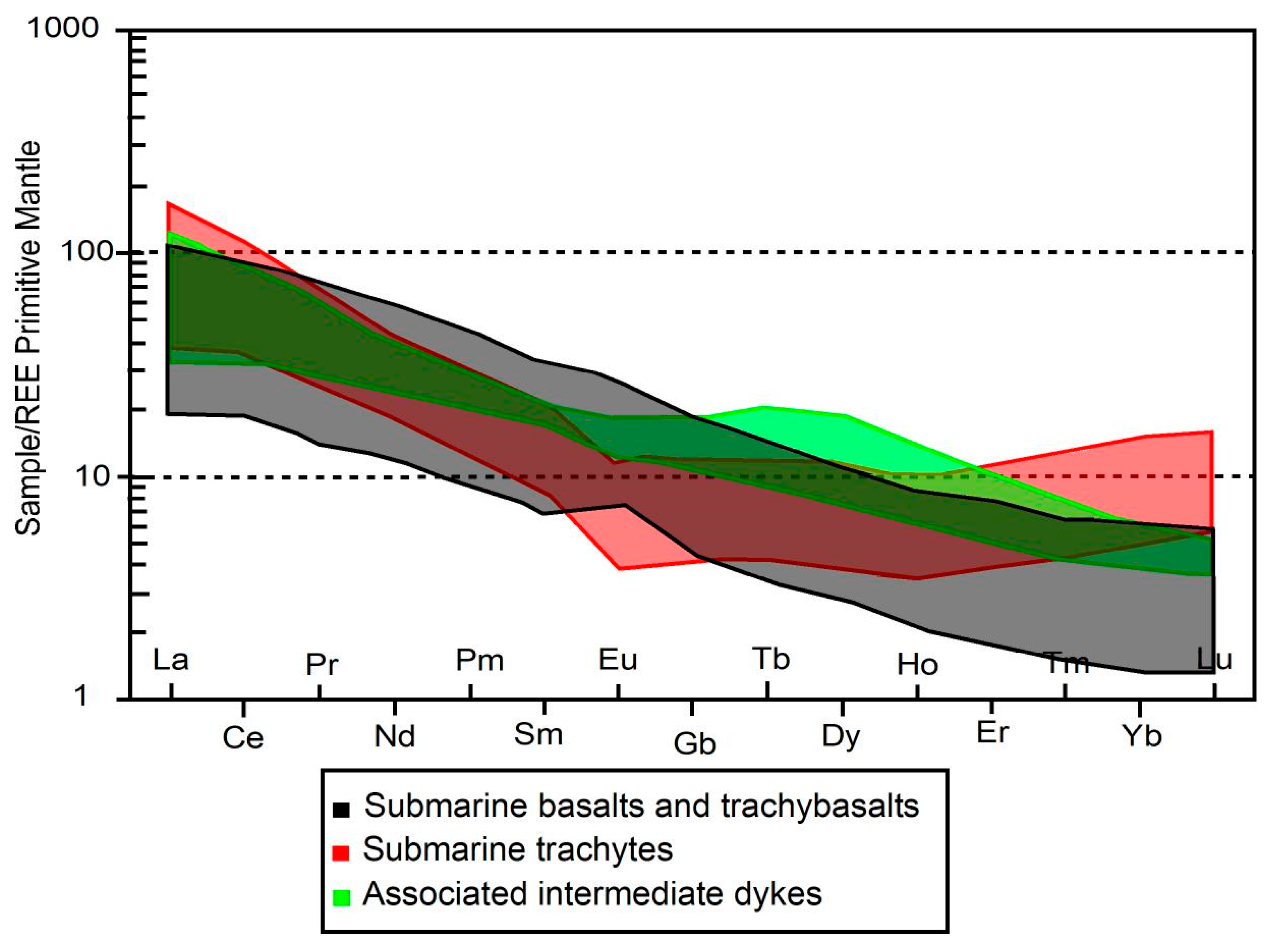
| Facies | Litology, Stratification, Textures, and Structures | Interpretation | |
|---|---|---|---|
| A | |||
| A: COHERENT FACIES | A1. TRACHYBASALTIC PILLOW LAVAS | Very vesiculated pillow lavas forming continuous tubes up to 1 m in diameter (Figure 4-1). Little hyaloclastic material occurs among the pillow lavas. | Lava flows from submarine trachybasaltic eruptions. |
| A2. LOBES OF VITREOUS OR APHANITE TRACHYTES | Aphanitic or vitreous trachytes in tubular bodies, in the form of lobes, with individual diameters varying between 0.5 and 1 m, superimposed until reaching thicknesses of up to 20 m. In the lobes (Figure 4-2), a zoning from core to edge is observed:
| Trachytic lobes (similar to those described by [217,218,219]. Here, they are described on oceanic islands for the first time. | |
| A3. LOBES OF PORPHYRITIC TRACHYTES | Light or gray porphyritic trachytes in tubular bodies, in the form of lobes, with individual diameters varying between 0.5 and 1 m, superimposed until reaching thicknesses of up to 30 m (Figure 4-3). Lobes may have no internal zoning with (subfacies A.3.1.) or without fluid texture (subfacies A.3.2.) or show a core-to-edge zonation (subfacies A.3.3.) (Figure 4-3C):
| Trachytic lobes (similar to those described by [217,218,219]. Here, they are described on oceanic islands for the first time. | |
| B | |||
| B: AUTOCLASTIC FACIES | B1: HYALOCLASTITES | Clast-to-matrix-supported monomictic breccia, poorly sorted, ungraded, with little matrix, arranged in massive layers less than 10 m thick with gradational contacts with adjacent trachytic bodies (Figure 4-4). Clasts up to 30 cm in size (2–3 cm on average), angular and subangular with polyhedral or “blocky” shapes, curviplanar margins, straight corners and, more rarely, with amoeboid shapes. Some exhibit “jigsaw-fit” or clast-rotated textures with gradual transit from the lobes to the breccias with jigsaw-fit textures and from these to the breccias with clasto-rotated textures. The nature of the clasts is the same as that of the adjacent trachytic lobes: porphyritic trachytes (subfacies B.1.1.), fluidal porphyritic trachytes (subfacies B.1.2.), or fluidal aphanitic trachytes (subfacies B.1.3.), with varied vesiculation (stretched or rounded vesicles). | “In situ” hyaloclastites, generated by fragmentation and contraction of the trachytic lobes due to rapid cooling in contact with sea water [220,221,222]. In submarine conditions, the contact of water with magma or with rock that is still hot produces non-explosive fragmentation due to supercooling and contraction, generating hyaloclastites. If the magma was in the process of degassing, the hyaloclastites appear with a high degree of vesiculation, giving rise to pumice-like clasts. |
| B2: AUTOBRECCIAS | Clast-supported monomictic breccia, poorly classified, massive and with little matrix, forming layers less than 3 m thick, although they can reach 10 m. Gradational contact with the trachytic lobes (Figure 4-5). Clasts between 3 cm and 50 cm, amoeboid in shape, or, more rarely, angular, and frequently plastically deformed. They present “jigsaw-fit” and clast-rotated textures. The nature of the clasts is the same as that of the adjacent trachytic lobes: porphyritic trachytes (subfacies B.2.1.), fluidal porphyritic trachytes (subfacies B.2.2.), or fluidal aphanitic trachytes (subfacies B.2.3.), with varied degrees of vesiculation (vesicles are stretched or rounded). | Auto-brecciation or fracturing of the edges of the trachytic lobes due to the shear or tensional stress that is generated between the moving magma and the edge of the already solidified lobe [218]. If fragmentation occurs under plastic conditions, the clasts are very irregular and adapt to each other [220]. If it is more brittle, clast accumulations with curviplanar surfaces occur [221]. | |
| C | |||
| C: RESEDIMENTED SYN-ERUPTIVE FACIES | C1: TRACHYTIC BRECCIAS, MASSIVE OR WITH SLIGHT NORMAL GRADING | Monomictic, clast-to-matrix-supported breccia, poorly sorted, massive or with slight normal grading, in layers up to 3 m thick (Figure 4-6A,B). Angular to subangular clasts, with an average diameter of 1.5 cm and maximum 20 cm, with polyhedral and, more rarely, amoeboid morphologies, of porphyritic trachytes and aphanitic, fluidal or not, and with varying degrees of vesiculation. | Submarine mass flows (debris flows) produced by the resedimentation of hyaloclastites and autobreccias [222]. |
| C2: POLYMICTIC MASSIVE BRECCIAS | Polymictic clast- and matrix-supported breccia, massive and very poorly classified, with clasts with diameters between 0.5 cm and 2 m (average 5 cm) (Figure 4-6C,D). The clasts are of a very varied nature: subangular with porphyritic trachytes; white trachytes with stretched vesicles; gray aphanitic trachytes and fluidal trachytes (of sizes greater than 2 m that appear to represent large fragments of trachytic lobes); and subangular clasts of trachybasalts and subrounded clasts of gabbros and monzonites. | Submarine mass flows (debris flows) produced by small avalanches of hyaloclastites, autobreccias, and lobes of the lobe–hyaloclastic complex and of the pillow lavas and breccias of fragments of trachybasaltic pillows. Clasts larger than 2 m appear to represent large fragments of the trachytic lobes. Subrounded clasts of gabbros and monzonites indicate abrasion during or prior to transportation. The subrounded plutonic rock pebbles could be enclaves transported by felsic magma torn from deep within an already solidified magma chamber, or come from a nearby emerged and exhumed volcanic edifices. | |
| C3: POLYMICTIC MASSIVE BRECCIAS WITH INVERSE GRADATION AT THE BASE | Mono- and polymictic clast- and matrix-supported breccia, medium to poorly sorted, of subrounded and subangular clasts with a minimum size of 2 cm and a maximum of 30 cm (average of 10 cm). Sand and gravel size matrix. The layers show inverse grading at the base and, in some cases, normal grading at the top. The clasts are porphyritic trachytes with a glassy or microcrystalline matrix and stretched vesicles; fluid porphyritic trachytes; aphanitic trachytes, vitreous, more or less fluid; porphyritic trachybasalts, very vesiculated, with curviplanar shapes (“pie pieces”) and curved cooling or amoeboid edges, and rounded edges of gabbros and monzonites. We distinguish the following subfacies: subfacies C.3.1. (Figure 4-7), if the clasts are exclusively porphyritic trachybasalts, very vesiculated, with curviplanar shapes (“pie pieces”) and curved or amoeboid edges; subfacies C.3.2. (Figure 4-8), if the clasts are exclusively trachytes; subfacies C.3.3. (Figure 4-9), if clasts of trachytes, trachybasalts, and gabbros, and monzonites exist. | Submarine gravity flows from the resedimentation of lobes, slipped pillow lavas, hyaloclastites, and autobreccias of trachytic or trachybasaltic composition. These subaqueous gravity flows would be “high-density gravelly turbidity currents” in the sense of [220]; or concentrated density flows of [223]) composed predominantly by grain size populations 2 and 3 of [224] or A and B by [225]. The observed facies would correspond to the R2 parts of a high-density turbidite defined by [220] or to the F2 deposits of an idealized turbidite by [225]. The subrounded clasts of plutonic rocks could have the same origin, as indicated for facies C2. | |
| C4: POLYMICTIC SANDSTONES AND BRECCIAS WITH INVERSE GRADING AT THE BASE | Coarse sandstones and breccias arranged in stacked inversely graded units 1 to 3 m thick, with subangular clasts of trachybasalts and porphyritic trachytes up to 20 cm in the upper part of each unit (Figure 4-10). The trachytes are highly vesiculated, reaching, in some cases, 40% vesiculation. | Submarine gravity flows possibly of turbidite currents: S2 of [224] resulting from transformation of the high-density gravel turbidite currents that formed the massive polymictic breccias with inverse grading at the base (C3). | |
| Sample | Chemical Classification | Position | N (N° of the Zircon Crystals) | Concord 206Pb/238U (207 Corrected) | Age (Ma) |
|---|---|---|---|---|---|
| TAB-12 | Trachyte | Las Angustias ravine (380 mts height) | 20 | 3.08 ± 0.1 | 3.10 ± 0.03 |
| TAB-23 | Trachyte | Las Angustias ravine (380 mts height) | 19 | 3.14 ± 0.05 | |
| TAB-24 | Trachyte | Las Angustias ravine (360 mts height) (El Carbón) | 20 | 3.13 ± 0.05 | |
| TAB-33B | Trachyte | Las Angustias ravine (390 mts height) | 20 | 3.06 ± 0.1 |
| Age (Ma) | |||||
|---|---|---|---|---|---|
| Sample | Chemical composition | Position | Normal isochron | Inverse isochron | Weighted plateau |
| TAB-28 (amphibole) | Trachybasalt | Las Angustias ravine (340 mts height) (El Carbón) | 2.49 ± 0.33 | 2.48 ± 0.32 | 2.48 ± 0.15 |
Disclaimer/Publisher’s Note: The statements, opinions and data contained in all publications are solely those of the individual author(s) and contributor(s) and not of MDPI and/or the editor(s). MDPI and/or the editor(s) disclaim responsibility for any injury to people or property resulting from any ideas, methods, instructions or products referred to in the content. |
© 2025 by the authors. Licensee MDPI, Basel, Switzerland. This article is an open access article distributed under the terms and conditions of the Creative Commons Attribution (CC BY) license (https://creativecommons.org/licenses/by/4.0/).
Share and Cite
Casillas, R.; de la Nuez, J.; Colmenero, J.R.; Fernández, C.; Jourdan, F.; Harangi, S.; Lukács, R. The Submarine Trachytic Lobe–Hyaloclastite Complex of the Caldera of Taburiente (La Palma, Canary Islands): The Age and Meaning of the Oldest Geological Formation on the Island. Minerals 2025, 15, 1007. https://doi.org/10.3390/min15101007
Casillas R, de la Nuez J, Colmenero JR, Fernández C, Jourdan F, Harangi S, Lukács R. The Submarine Trachytic Lobe–Hyaloclastite Complex of the Caldera of Taburiente (La Palma, Canary Islands): The Age and Meaning of the Oldest Geological Formation on the Island. Minerals. 2025; 15(10):1007. https://doi.org/10.3390/min15101007
Chicago/Turabian StyleCasillas, Ramón, Julio de la Nuez, Juan Ramón Colmenero, Carlos Fernández, Fred Jourdan, Szabolcs Harangi, and Réka Lukács. 2025. "The Submarine Trachytic Lobe–Hyaloclastite Complex of the Caldera of Taburiente (La Palma, Canary Islands): The Age and Meaning of the Oldest Geological Formation on the Island" Minerals 15, no. 10: 1007. https://doi.org/10.3390/min15101007
APA StyleCasillas, R., de la Nuez, J., Colmenero, J. R., Fernández, C., Jourdan, F., Harangi, S., & Lukács, R. (2025). The Submarine Trachytic Lobe–Hyaloclastite Complex of the Caldera of Taburiente (La Palma, Canary Islands): The Age and Meaning of the Oldest Geological Formation on the Island. Minerals, 15(10), 1007. https://doi.org/10.3390/min15101007






